北欧绿色邮报网报道(记者陈雪霏)– 诺贝尔化学奖2023即将在今天上午11:45揭晓。届时瑞典皇家科学院秘书长爱乐格伦将宣布获奖者名单。
昨天是诺贝尔物理学奖宣布。德国科学家Agostini, 美国科学家Krausz,和瑞典科学家L’Huillier可能是法国人但在瑞典隆德大学任教。他们三人分享诺贝尔物理学奖。获奖理由是他们在最短时间内研究分子原子内部电子的活动,阿秒光脉冲试验。
他们将在12月10日在斯德哥尔摩音乐厅从国王手中接过奖状和奖杯,并受到国王的宴请。
北欧绿色邮报网报道(记者陈雪霏)– 诺贝尔化学奖2023即将在今天上午11:45揭晓。届时瑞典皇家科学院秘书长爱乐格伦将宣布获奖者名单。
昨天是诺贝尔物理学奖宣布。德国科学家Agostini, 美国科学家Krausz,和瑞典科学家L’Huillier可能是法国人但在瑞典隆德大学任教。他们三人分享诺贝尔物理学奖。获奖理由是他们在最短时间内研究分子原子内部电子的活动,阿秒光脉冲试验。
他们将在12月10日在斯德哥尔摩音乐厅从国王手中接过奖状和奖杯,并受到国王的宴请。
北欧绿色邮报网援引瑞典电台3月21日报道,瑞典人对乌克兰局势的担忧正在对职场产生影响。
职业健康诊所的心理学家 Anna Wickberg 说,很多人打电话咨询是因为他们受乌克兰亲戚的影响,或者因为他们自己曾经逃离过战争。还有一部分人担心战争会逼近瑞典,或担心自己难以工作和管理生活。
Anna Wickberg 认为,由于人类喜欢可预测性的生活,因此在不确定的情况下产生焦虑反应是完全正常和自然的。
焦虑可能包括心悸、头晕、疼痛、食欲下降、强烈和快速变化的情绪或难以集中注意力等表现。其后果是病假增加、生产减少和员工流动率增加。
职业健康机构(Feelgood)的首席心理学家 Faysal Rawandozi 认为,乌克兰的亲戚是增加瑞典人焦虑的直接原因。另外,在职场中如何与想法不同的同事打交道也是导致焦虑的一大因素。
Faysal Rawandozi 和 Anna Wickberg都强调,高层管理人员必须制定一个计划,以了解和处理员工的担忧,询问员工的感受。在工作中营造充满希望的氛围。定期告知员工正在发生的事情、建立秩序和维持常规也有助于营造安全感与平和感。
Anna Wickberg 表示,如果员工之前经历过战争或在乌克兰、俄罗斯有亲戚,定期跟进他们的感受和需求尤为重要。
本来,新冠肺炎已经让很多人的精神健康受到了挑战。战争加剧了这种焦虑。

北欧绿色邮报网和北欧中华网(记者招陈雪霏 查正富)并网报道 当地时间10月11日,瑞典皇家科学院将2021年诺贝尔经济学奖一半授予大卫·卡德David Card,因他对“劳动经济学的实证”贡献;另一半授予约书亚·安格里斯特Joshua D. Angrist和吉多·伊本斯Guido W. Imbens,表彰他们对“因果关系分析的方法论”贡献。
大卫·卡德,1956年生于加拿大圭尔夫,现为加州大学伯克利分校经济学教授,美国与加拿大双重国籍。
约书亚·安格里斯特,1960年出生于美国俄亥俄州哥伦布市,现为麻省理工学院经济学教授。
吉多·伊本斯,1963年出生于荷兰埃因霍温,现为斯坦福大学应用计量经济学与经济学教授,美国与荷兰双重国籍。
官网称,今年的获奖者大卫·卡德、约书亚·安格里斯特和吉多·伊本斯为我们提供了关于劳动力市场的新见解,并向我们展示了从自然实验中可以得出哪些因果结论。他们的方法已经扩展到其他领域,彻底改变了实证研究。
“社会科学中的许多重大问题都与因果有关。移民如何影响薪酬和就业水平?更长时间的教育如何影响一个人未来的收入?这些问题很难回答,因为我们没有任何东西可以比较。我们不知道,如果移民人数减少或该人没有继续学习,会发生什么情况。 然而,今年的获奖者已经证明,用自然实验来回答这些和类似的问题是可能的。关键是要避免出现这样的情况:偶然事件或政策变化导致某些群体受到不同的对待,就像医学临床试验那样。”官网称。
大卫·卡德利用自然实验分析了最低工资、移民和教育对劳动力市场的影响。他在20世纪90年代初的研究挑战了传统,带来了新的分析和更多的见解。结果表明,提高最低工资并不一定导致就业减少——在一个国家出生的人的收入可以从新移民中受益,而较早移民的人则面临受到负面影响的风险。而学校的资源对于学生未来在劳动力市场上取得成功的重要性远远超过之前的预期。 然而,来自自然实验的数据很难解释。例如,将一组学生(而不是另一组学生)的义务教育延长一年不会以同样的方式影响该组中的每个人。有些学生本来会继续学习,而对他们来说,教育的价值往往不能代表整个群体。20世纪90年代中期,约书亚·安格里斯特和吉多·伊本斯解决了这个方法论问题,展示了如何从自然实验中得出关于因果的精确结论。
“卡德对社会核心问题的研究以及安格里斯特和伊本斯在方法论上的贡献表明,自然实验是丰富的知识来源。他们的研究极大地提高了我们回答关键因果问题的能力,这对社会大有裨益,”经济科学奖委员会主席彼得·弗雷德里克森(Peter Fredriksson)表示。
诺贝尔经济学奖至今一共颁发了53次,共有89人获奖,其中2位女性获奖。86名获奖者中,最年轻的获奖者是2019年的获奖者之一埃丝特·迪弗洛(Esther Duflo),时年46岁;最年长的获奖者是2007年的获奖者之一莱昂尼德·赫维奇(Leonid Hurwicz),时年90岁。(稿件来源央视新闻客户端)
Christopher Ford , Tuesday 31 Aug 2021
Christopher Ford published his side of the story in the State Department of the United States about the Lab leak Inquiry. The following is the whole article.
In both journalism and policymaking — if not always in politics, or in the sordid world of score-settling by unemployed, second-rate apparatchiks — facts matter, and intellectual integrity matters. In light of the remarkable quantity of errant nonsense that has been written in the last couple of weeks about squabbles inside the U.S. State Department about how to look into the origins of SARS-CoV-2 in the closing weeks of the Trump Administration, I hope this open letter will help set the record straight for those who still care about things such as facts.
I write this because, to put it bluntly, I’m tired of being the butt of stupid and paranoid conspiracy theories being promulgated by those who know better. I recognize that some of these conspiracy narratives are, for any thoughtful person, self-refuting even on their face. (As someone who has been warning the policy community since at least 2007 about threats to the United States and the democratic world from the Chinese Communist Party’s geopolitical ambitions — including in two scholarly books and scores of articles and speeches, including in official capacity at the State Department — have I been “protecting” the Chinese Communist Party from accountability? Good grief.)
Nevertheless, I’ve been around politics long enough to know that an imbecility that slots into a convenient narrative beats an awkward fact any day, and manic performative outrage is much more fun than sober analysis. So perhaps offering clarity here won’t change a thing. Yet I’m still going to try.
I’m also going to try to do something unorthodox here. Rather than using this letter as an opportunity to invent and loudly dispense my own post hoc version of what happened — a dishonest revisionism-of-convenience that is in abundant supply, but that I will leave to others — I will try to offer you only specific claims that are supported by contemporaneous documents that enterprising journalists at Fox News and Vanity Fair have recently put into the public record.
Part One: A Clear Documentary Record
In particular, since the question at hand is my own particular role and position in connection with investigating the origins of the COVID-19 virus, I will refer to three unclassified documents that I myself wrote and sent to others at the State Department in early January 2021. (For the record, I did not retain these documents when I left the Department. Thankfully, however — at least for me — some of the lies being told on these topics have apparently caused offense among those who know what really happened and clearly did retain the documents.) I’m happy to see them in the public record, because they make very clear exactly what I was doing at the time, and why.
The documents are as follows:
1. An e-mail I sent to Tom DiNanno and David Asher on January 4, 2021, which can be found here thanks to Fox News;
2. An e-mail exchange between me and DiNanno on January 5–6, which can be found here thanks to Fox News; and
3. A message I sent to a number of senior State Department officials on January 8, which can be found here thanks to Vanity Fair.
Part Two: Pushing for an Honest and Defensible Lab-Leak Inquiry
So let me begin with a critical point. As detailed in these documents, the squabbling at the State Department was about trying to ensure that we got our facts straight before going public with dramatic steps such as having Secretary Pompeo announce that it was “statistically” impossible for SARS-CoV-2 to be anything other than the product of Chinese government manipulation, sending “demarches” to foreign governments with this theory, or writing up China for having violated the Biological Weapons Convention (BWC) in connection with COVID-19.
The dispute had nothing whatsoever to do with trying to quash investigation into the origins of the virus, and everything to do with trying to ensure the honesty and intellectual integrity of that investigation precisely because it was vital for us to get the bottom of the question of COVID “origins,” including the possibility that it came from the Wuhan Institute of Virology (WIV). I strongly supported looking into the “lab-leak” hypothesis, which clearly is a real possibility.
But I’m not just saying this now. I said it at the time, too. A lot.
Let’s look at the documents, starting with my January 4 e-mail to DiNanno and Asher. In that message, I highlight that the Arms Control, Verification and Compliance (AVC) Bureau’s scientific “allegations about WIV and Chinese BW work allegedly being the source” of SARS-CoV-2 were “important” and “worrying,” and that these significant claims needed to be evaluated by real scientific experts.
(Yes, I admit that I called the virus the “WuFlu.” At a time before the World Health Organization had come up with “non-stigmatizing” designators such as “Alpha,” and people talked freely about things like the “UK variant” or “South African variant,” it didn’t seem unfair to tag the original virus as having indeed come from Wuhan. I’m afraid at another point I called it the “KungFlu,” too. None of this sounds as clever to me in retrospect as I fear it did at the time. But please remember that these were internal e-mails, not intended to see the light of day. Had I written these messages with an eye to public release, I would not have been so glib. Mea culpa.)
Anyway, in my e-mail, I reminded DiNanno and Asher that I had directed them, a month or so earlier, to establish an “expert vetting group or process” that would involve real scientists and intelligence experts in assessing the strength of AVC’s claims. But why, I asked them, had there been no progress in subjecting their assertions to peer review? And why were they running around the interagency spreading these allegations before we knew whether these claims could pass muster with objective, third-party scientists?
As I stated in that January 4 message, I wanted to “demand[] more transparency from the PRC here, especially in light of their appalling early cover-up of COVID-19 during the early weeks when honesty and resolute action could have made such a colossal difference in heading off millions of deaths and untold suffering, and in light of their grotesque history of such cover-ups.”
“An investigation of [COVID] origins is very important,” I reiterated, “and I’m delighted to press their feet to the fire for the honesty and clarity they’ve so far refused to provide.”
In the January 4 message, however, I also stressed how important it was that we get our facts straight before going public, as the U.S. Government, with the accusation that the Chinese government created the virus:
“[W]e need to make sure what we say is solid and passes muster from real experts before we risk embarrassing and discrediting ourselves in public. … As I have repeatedly said, if it turns out that your conclusions are right, I’ll happily be first in line to scream from the rooftops about them, for it would be a colossal outrage. And you may well be right. But I want to be confident about where the facts really lie …. These issues are surpassingly important and we need to get to the bottom of them — but rigorously, defensibly, and truly.”
Hence my annoyance, expressed in that message, that DiNanno had been dragging his feet over my direction to “arrang[e] expert-level bioscience and intelligence vetting of David [Asher’s] work.” I warned DiNanno that such dithering looked bad: “Please don’t continue to feed the impression that AVC is afraid of peer review.” And I insisted that he tell me when they actually planned to get those allegations vetted by real scientists. It’s all there in the e-mail.
The next day, January 5, when I still hadn’t heard back from DiNanno about how they would ensure that their scientific assertions got evaluated by actual scientists, I e-mailed him again. (This was the message at the bottom of the January 5–6 e-mail string Fox News published.) I’ll admit I was grumpy, but I think I was also pretty clear about my focus on ensuring that we got our facts straight on this critical issue of COVID origins:
“It is … becoming embarrassing — and, if I may say so, more than a little worrisome — that AVC seems still to be ducking an expert-level engagement to evaluate its own WIV allegations, even while it has continued, over the last month or so, to brief its claims to non-experts across the interagency.”
DiNanno responded to my January 5 message with platitudes about how all they were doing was “investigating potential arms control violations.” (This is the middle message in the January 5–6 string.) “That Is [sic] exactly what we have done,” he declared, “and will continue to do.”
Let’s pause here for a moment. If you’re paying attention, you’ll have noticed that with this comment about “investigating potential arms control violations,” DiNanno signaled that AVC regarded itself as focusing not so much upon the origins of SARS-CoV-2, per se, as more specifically upon China allegedly having violated the Biological Weapons Convention by creating the virus. They seemed to believe that COVID-19 was a biological weapons (BW) effort gone awry — or perhaps even a BW agent deliberately unleashed upon the world after Beijing had secretly vaccinated its population, as Asher has rather remarkably suggested in public now that the State Department has terminated his consultancy contract. (You can see him in all his sober, cautious, and methodical glory on YouTube.) In this context, I suppose it was hardly surprising — as I memorialized in my January 4 e-mail to DiNanno — that in the December briefing when AVC first pitched me on their WIV-origins theory, Asher at one point suggested that SARS-CoV-2 might be a “genetically selective agent” (GSA) that China was using to target us, as evidenced, he said, by the fact that Sub-Saharan Africa wasn’t reporting many COVID cases while the United States was. (Surely you don’t need me to spell out how that notion was both analytically unsupportable on its face and contained deeply offensive implications, do you? I’ll leave you to work this out on your own, but, uh, wow.)
Fortunately, however, DiNanno also informed me in his January 5 response that AVC had now indeed set up a panel of experts to discuss the scientific claims, which would occur on Thursday evening, January 7. (Finally! As noted in my January 4 e-mail, I’d been demanding expert vetting of AVC’s “statistical” argument since they first came to me with this issue in my office in December.)
As this panel approached, however, I wrote DiNanno again — on January 6 — to emphasize how important it was that we get real scientists to vet AVC’s allegations before we surfaced such dramatic claims in public:
“As I indicated before, having something that sounds scientific to say when making assertions to laymen is not the same thing as being correct. I do not have the scientific expertise to critique David’s claims. Nor do you. Nor, in fact, does he have actual technical training in the first place. That doesn’t necessarily mean he’s wrong, of course, but it does have implications for how to deal with the complex and controversial claims you guys are making about weedy bioscience. … If you’re right, you should be willing to prove it, and to confront experts who — unlike all of the people involved in building and making this argument for you — actually have training in the scientific field about which you make assertions. I really don’t know how I could possibly have been more clear about this over the course of the last month. Your allegations are dramatic, and potentially very significant indeed, but it’s for precisely that reason that they need to be tested and evaluated carefully. …Your claims need to be assessed by real experts — not just waved around as bullet points on slide decks in front of non-scientists who are then dared to prove you wrong.”
It was particularly important to get real expert-level assessment of the scientific assertions AVC was making about laboratory origin because the AVC investigation appeared to have carefully bypassed State Department experts — both in my own bureau and in AVC itself, each of which has a whole office devoted to such questions — and the U.S. Intelligence Community. As I recounted in my January 8 message, “AVC ha[s] apparently been briefing this argument inside the Department and [to] some interagency partners for some weeks, apparently on instructions from a staffer at S/P [the Department’s Office of Policy Planning] who told them they should not inform me or others of this work, nor involve the Intelligence Community.”
(A footnote, but perhaps a significant one: That last bit about cutting real experts out of the loop came to me directly from Tom DiNanno. When I asked him why AVC had been doing all this without telling the senior official to whom they reported — that is, me — he told me sheepishly that he had been instructed to do things this way by Miles Yu, an S/P staffer at the time. According to DiNanno, Yu had represented that these specific instructions came from the Secretary. DiNanno, then in charge of the verification bureau, gave no sign of ever actually having verified that this was true, however. He appeared to have accepted Yu’s representations at face value — in effect, a de facto Assistant Secretary of State taking marching orders from a lower-ranking staffer in another bureau, sight unseen. It would be interesting, now, to find out whether: (1) Secretary Pompeo really directed that AVC’s lab-leak inquiry avoid engaging Departmental BW experts and U.S. intelligence officials, and that it do its work essentially in secret, without telling the official performing the duties of the Under Secretary for Arms Control and International Security; (2) Yu was, at least in this respect, dishonestly freelancing; or (3) DiNanno was just lying to me about his conversation with Yu. Perhaps a good journalist can go figure this out.)
Part Three: The Scientific Panel
Anyway, at least a first chance for scientific vetting came on January 7, when the panel of experts picked by the AVC Bureau had a chance to discuss the “statistical” proof that AVC had been relying upon in its assertions to me and others that the SARS-CoV-2 virus had to have been the product of Chinese government manipulation.
Unfortunately, as I memorialized the next day (January 8), despite my urging — in the last three paragraphs of my January 6 e-mail — that the other members of the panel “have … the benefit of actually being able to read the paper beforehand,” AVC had not shared the document ahead of time. As I observed on January 8, “AVC did not provide us with the actual paper before yesterday’s discussion, so most other participants had not had the chance to study it in detail.”
Even so, it did not take the other panelists long to point out some key flaws in the “statistical” argument, which had been presented orally to the panel by the scientist upon whom AVC had apparently most relied in developing that line of argument. (His name is widely known, but I opted not to single him out in my message to Departmental colleagues. I felt that scientists should have some freedom to figure out the science amongst themselves; my concern was with what the U.S. Government would assert after they did. Rather than drag him personally into the fray, therefore, my memo reflected the fact that this man’s claims had effectively become AVC’s argument as the bureau promoted them in the interagency.)
I’ll spare you the blow-by-blow of criticisms made by other panelists about the “statistical” case AVC had been making at least since the first briefing they gave me in my office in December, though you can read the salient details in the January 8 message I sent to a number of my senior State Department colleagues the next day. (My message focused on the statistical argument, given the prominence it had enjoyed in AVC’s briefings; I did not purport to summarize the panel’s discussion of all matters raised.) As you’ll see if you care to read my several-page account on January 8, the assertions AVC had been making seemed to have major problems. At the least, those assertions were clearly not yet ready to be the official position of the U.S. Department of State — which is why I sent that January 8 message warning my colleagues to be careful about running with that particular “statistical” claim.
I also now know, thanks to Vanity Fair, that DiNanno responded to my January 8 memo with one of his own a day or two later, after I had left the Department. The reader can find it online, so I won’t walk through it here. In light of what you now know from documentary evidence about my actual positions at the time, however, you’ll easily be able to see what a pack of distortions and falsehoods DiNanno’s memo actually was. You might want to lay our two documents side by side and read them carefully in light of the information you now have. I suspect it will be pretty clear that his memo was a dishonest mess of baseless attacks on me — an angry screed addressed to readers whom DiNanno knew did not have the benefit of knowing what I’d actually been saying to him for the last month, and which he sent to his readers at a time when he knew I had resigned from the Department and would have no chance to defend myself and correct the record. (Thankfully, however, our bosses were intelligent folks. One can probably infer how seriously our superiors took DiNanno’s memo by the fact that they apparently acted on my note of caution about AVC’s scientific claims rather than on DiNanno’s shrill and convoluted attempt to defend those assertions and paint me as the villain. More on that below.)
For purposes of this open letter, I’ll leave the issues of science to any of you who are scientists. As I told DiNanno in my January 4 message, “I do not have the scientific expertise to critique David’s claims. Nor do you. Nor, in fact, does he have actual technical training in the first place.” That is precisely why I insisted that AVC set up a panel of experts, and why — after they finally got around to arranging this peer review on January 7 — it was my duty to convey to my colleagues some of the concerns raised by the experts AVC had put on the panel. It may in the end turn out that science does prove that SARS-CoV-2 was the result of human intervention at WIV. But it would have been grievously irresponsible for us to adopt that theory publicly until it was much more able to stand on its own two feet that the January 7 panel discussion showed it to be at the time.
Part Four: Putting Absurd Accusations to Rest
Some of my former colleagues are now — perhaps, one imagines, out of embarrassment over all of the events described above — asserting that I tried to prevent inquiry into the lab-leak hypothesis and to shut down any investigation of the question. (Thanks to Tucker Carlson making this claim at least twice on the air, by the way, I’ve now gotten vicious and deranged hate mail. Here’s, for instance, what I received on June 3 after Carlson first mentioned me on his show: “Fuck you dickbag globalist shill. Why the fuck did you shut down the lab leak theory? Go lick some China communist boots.” This person helpfully signed this missive cantcuckthetuck@gmail.com. Thanks for introducing me to new friends, Tucker.)
Yet no serious person who is actually aware of my interactions with AVC could possibly think I wanted to prevent inquiry into the laboratory hypothesis, as you will already have seen from my e-mails of January 4 and January 5–6, from which I’ve quoted extensively here. (You can even read them online yourself, in their entirety.) You can also see that I was always crystal clear about the importance of getting to the truth by fully investigating the laboratory-leak question, making clear that “if it turns out that [AVC’s] conclusions are right,” I would myself “happily be first in line to scream from the rooftops about them.”
Additional proof of my commitment to looking into WIV — and indeed my focus upon protecting efforts to investigate the laboratory-leak question from the discredit and ridicule that might have smothered it in its crib if we had foolishly hitched Secretary Pompeo, the Department of State, and the Administration to easily-debunkable junk science — can be found in my January 8 message itself. There, I made the point yet again:
“If well-founded, AVC’s findings would be extremely significant …. All participants [in the January 7 panel] seemed … to agree that China should be pressed for answers about such things as the nature of any work done at WIV on novel coronaviruses, whether any safety incidents occurred, what data is in WIV’s sequencing database (which was mysteriously taken offline early in the pandemic), and when exactly the PRC realized (despite its early representations) that SARS-CoV-2 was only in its ‘wet market’ environmental samples — and not in its live animal samples — leading them to conclude that the market was not the source of the outbreak. These sorts of questions should indeed provide us with lots of grist for pressing China for answers and highlighting its non-transparency and history of failing to report (or even covering up) critical information.”
You’ll also see from my January 8 message that I specifically directed “AVC and ISN [the International Security and Nonproliferation Bureau] to collaborate on drawing up a list of questions and points that could be useful in this regard” in pressing Beijing for answers. So were these the actions of a “dickbag globalist shill” who “lick[s] … China communist boots”? Or of a serious steward of the honesty and intellectual integrity of U.S. State Department policymaking dedicated to ensuring we got our facts straight and pushing back against recklessness that would make it harder to have the lab-leak issue taken seriously? The reader can make up his or her own mind.
Part Five: A Net Assessment
So where does that leave us now?
Well, if you want to understand what I was trying to do during in this period of bickering inside the State Department, you now have my own words from internal contemporaneous records. Simply put, I felt it would be essentially insane to go public with AVC’s scientific assertions — such as, as DiNanno and Asher had urged, making public statements, demarching foreign governments (including China), and finding China in violation of the Biological Weapons Convention over this coronavirus — before getting those scientific assertions vetted by objective, third-party scientists.
Let me be completely clear: From where I was sitting at the time, in the chair of the Under Secretary of State for Arms Control and International Security, I never saw any evidence of any effort at the State Department to prevent inquiry into the lab-leak idea. To the contrary — as you can now see proven by documents in the public record — I supported looking into the lab-leak hypothesis. I cared so much about getting to the truth about WIV, in fact, that I insisted that we do the work in a way that could stand up to scrutiny. (If you’re serious about something being done, you have an obligation to ensure it’s done right. Wanting less than that just makes you a hack.) And I am aware of no one anywhere in the Department who thought that the laboratory hypothesis should be ignored or ruled out.
So there was no conspiracy to quash inquiry into the lab-leak question, at least not at the State Department. But there was a demand for intellectual rigor and analytically defensible conclusions in doing that important inquiry. For making that demand, however, I make no apologies. I was doing my duty.
What happened after that? Well, one might infer that my State Department superiors in fact agreed with the account in my January 8 message of the weaknesses that AVC’s expert panel had pointed out in the supposed “statistical” proof that SARS-CoV-2 had to be the result of human intervention. Neither Secretary Pompeo nor any other serving U.S. official, after all, adopted and voiced the scientific assertions about WIV origin that AVC had previously been briefing to interagency stakeholders. Instead, Secretary Pompeo issued a “Fact Sheet” on January 15 that accurately recounted downgraded intelligence reporting we had received that seemed relevant to the question of whether COVID-19 had originated at the laboratory.
My superiors at the Department were not shy people, and I have no doubt that had they felt AVC’s scientific assertions could pass muster with real scientists, they absolutely would have made this case in public, and loudly. They chose not to do so, however. I suspect that we should read into this their quiet endorsement of my conclusion that AVC’s scientific case wasn’t ready for prime time. (Perhaps someone can ask my former bosses what precisely they thought of the merit of AVC’s “statistical” argument about genomic variation, and why — if it was indeed good science — they seem to have dropped those assertions. I can tell you only one thing about this with certainty: not pursuing AVC’s “scientific” argument after the January 7 panel meeting wasn’t my decision. By the end of the day on January 8, after sending my message of caution, I had left the Department. It would be interesting to know what discussions happened thereafter.)
But I do think that what happened next is important. Instead of focusing on purported “scientific proofs” of laboratory origin, public discussion of the COVID-origins issue thereafter shifted to the questions and suspicions that had been raised about WIV by our intelligence information, as outlined in Secretary Pompeo’s “Fact Sheet.” This was, in my view, much the better way to go. Before leaving the Department, in fact, I had myself reviewed and cleared an early draft of that “Fact Sheet” as the downgraded information started to go around for interagency clearance, and I was glad to see it later emerge publicly on January 15. Tellingly, the Biden Administration has not questioned that information, and a robust debate is now underway about possible laboratory origin.
But let me be frank. Anyone who cares about ensuring that the lab-leak hypothesis is taken seriously should probably be thanking me, rather than vilifying me. I suspect that my push for scientific vetting of AVC’s assertions actually helped save the lab-leak hypothesis from being preemptively discredited. The fact that we finally now have a credible public debate on the question owes much to the fact that pursuing these issues wasn’t tainted by the State Department signing the U.S. Government’s name to scientific assertions that we already knew hadn’t stood up well to scrutiny.
I’ve been around the arms control and international security business for quite a while now, including spending 2003–06 as Principal Deputy Assistant Secretary in what is now the AVC Bureau. As I told someone the other day — an old and dear friend and former colleague who has now started demonizing me on the basis of the lies being spread about these issues — honesty, accuracy, and intellectual integrity are the strongest weapons that an arms control verifier has. These things need to be safeguarded carefully, for they are priceless. They are what separates the truth-teller from the ideological crank.
I am heartsick at the ugliness of the campaign against me in the press today, but I remain proud of my role in insisting upon fidelity to these values at a time when some officials seemed to be slipping. I dearly hope that we can all now put fratricidal distractions aside and get back to the real task: figuring out what the hell happened in Wuhan.
Part Six: Conclusion
The actual details of all this State Department infighting are, I’ll admit, somewhat boring. They certainly don’t map satisfyingly onto a moralistic narrative of redoubtable heroes fighting for right against malevolent cabals and institutional corruption. Nor are they well suited for spinning up rants of performative outrage by the occasional pundit disinclined to let little things like “truth” get in the way of the good Nielsen ratings that come from spinning a sexy narrative of deceit and conspiracy.
Nevertheless, these demonstrable facts about the positions I took at the time are clear in the record. If that’s not important to you, you’re reading the wrong letter, and I apologize for wasting your time.
If you’ve read this far, however, my guess is that facts are indeed important to you. So thanks for listening.
………………….
*Dr. Ford served until January 8, 2021, as Assistant Secretary of State for International Security and Nonproliferation, and for the last 15 months of that period also performed the duties of the Under Secretary of State for Arms Control and International Security. Prior to that service at the State Department, he ran the Weapons of Mass Destruction and Counterproliferation Directorate at the U.S. National Security Council staff. A graduate of Harvard, Oxford University as a Rhodes Scholar, and the Yale Law School, Dr. Ford has been a think tank scholar, U.S. Navy intelligence officer, a staff member on five different U.S. Senate Committees, and a senior American diplomat. He is the author of two books on Chinese foreign relations and scores of articles on international security topics, and his personal website may be found at https://www.newparadigmsforum.com.
*Dr. Ford is a former diplomat, Senate staffer, naval intelligence officer, and think tank scholar who works and writes on foreign and national security policy.
Source Link:
“我很喜欢中国,很开心一直有人申请来我们这里,我也喜欢和中国人一起工作。我们也很喜欢中国的酒。”

北欧绿色邮报网援引新京报(记者 谢莲 栾若曦 姚远 )报道 北京时间10月6日下午,瑞典皇家科学院宣布,将2021年诺贝尔化学奖授予本亚明·利斯特(Benjamin List)和戴维·麦克米伦(David MacMillan),以表彰他们“在不对称有机催化的发展”方面的贡献。
北京时间10月8日下午,新京报记者独家连线目前正在德国的本亚明·利斯特教授,揭开这位新晋诺贝尔化学奖得主获奖背后的故事。本亚明·利斯特1968年出生于德国法兰克福,目前是德国马克斯·普朗克煤炭研究所主任之一。除此之外,他还是德国科隆大学有机化学教授。
接到瑞典皇家科学院打来的电话时,利斯特和妻子正在阿姆斯特丹的一家餐厅准备吃饭,他的第一反应是这是一个玩笑。他多年的朋友、另一位获奖者麦克米伦最初也认为这是恶作剧,甚至和利斯特打赌1000美元,称这不是真的。
利斯特11岁的时候就对化学非常感兴趣,而正是这份热爱让他将化学作为终身的事业。在他看来,有热爱就会有激情,即使枯燥的实验室研究也会变得有趣起来。他对年轻研究者的建议是,不要将获得诺贝尔奖作为唯一目标,“这不是你能计划的事情,你能计划的是过一段快乐的人生”。
在采访过程中,利斯特几次表达了对中国的喜爱。他提到了钢琴家郎朗、提到了中国的酒,甚至还说了中文。他表示,喜欢中国人热情稳健的风格以及积极乐观的面貌。
━━━━━
“人生最美好的时刻之一”

新京报:回到你接到获奖电话的那一刻,当时你在做什么?得知获奖的心情如何?
利斯特:截至目前,那是我人生最美好的时刻之一。我和妻子当时在阿姆斯特丹的一家餐厅,原本正打算点个早餐,我的手机突然响了起来。我虽然知道那天是宣布诺贝尔化学奖归属的日子,但是我绝没有想到诺贝尔化学奖会给我。
我把手机从口袋里拿出来,屏幕显示是从瑞典打来,我妻子看见了还打趣说,“这就是那通电话了”。我走出饭店接了电话,没想到还真的是瑞典皇家科学院,我当时不知所措,非常激动。能与家人分享这一刻,我也很开心。
新京报:这次诺贝尔化学奖是由你和戴维·麦克米伦共同分享,麦克米伦与你用1000美元打赌,称得奖这事不是真的,这背后有怎样的故事?
利斯特:他真的太有趣了。在我挂断电话的几分钟之后,诺贝尔委员会又打过来问我是否有麦克米伦的电话号码。给完对方号码,我赶紧给麦克米伦发短信,“戴维,起床”。他回了我一个电话,说不好意思,他很确信这就是个恶作剧,他的学生总开这种玩笑,干这些傻事。他甚至可以打赌1000美元,我同意和他打这个赌。
随后我给诺贝尔委员会打了电话,“现在是时候联系他了”。大概一分钟后,戴维说道,今晚无法入眠,他终于相信了得奖是真的,这太有意思了。
新京报:你和麦克米伦已经认识很多年了吗?你们二位曾经一起工作过吗?
利斯特:我们从1999年末就认识彼此,至今已经22年了。我们也曾经是竞争对手,不过就我看来,这种竞争一直建立在对彼此创造力的尊重和赞赏之上。

新京报:这次诺贝尔化学奖是为了表彰你们“在不对称有机催化的发展”方面的贡献。你可以用较通俗的话语解释一下你的研究工作吗?
利斯特:首先,即便不是化学家,了解催化作用对日常生活也非常重要。据估计,催化作用对全球生产总值的贡献占比达三分之一。如果数据准确,我认为,催化作用对我们的生活至关重要,催化同样也是伟大的科学。我总喜欢说,(研究)催化作用是化学家最接近魔法的时候。
因为催化剂的美妙之处在于,通过一个催化剂分子可以创造出成千上万的分子,不可思议的复制效应正是催化作用的神奇之处,这就是我们身处其中的原因。
大约20年前,我刚刚开始这项工作的时候,只有两种催化剂,一种基于金属,另一种基于生物。麦克米伦教授和我、我们的团队,发现有机分子也可以作为催化剂,例如氨基酸。这真的是很大的突破,因为氨基酸无毒,它们很容易从植物或者鸡毛等环境中提取,是很好的催化剂。它们的意义就在于可以被用于制作药剂,事实上,现在许多药剂的制作过程都在使用有机分子作为催化剂。
新京报:不对称有机催化对民众的日常生活而言,还有哪些应用场景?这项研究对于普通民众的意义是什么?
利斯特:在如今的背景下,我想强调不对称有机催化的抗病毒性(antivirus)。我们正处于新冠疫情大流行之中,整个世界都在其中挣扎。治疗病毒有许多不同的方法,例如疫苗,这是我们应对当前疫情的方法。但是有些病毒无法用接种疫苗的方式来解决,例如艾滋病病毒(HIV),艾滋病可能是人类遭遇的最严重的一场流行病,它能得以控制的原因在于,感染者可以通过服用小分子药物过上正常生活,而其中一种药物就是通过有机催化制作。
新京报:以往的诺贝尔化学奖经常颁给生物化学、分子生物、物理化学等学科的研究者,导致许多人称其为“理综奖”。但今年的诺贝尔化学奖似乎回归了纯粹的化学研究领域。对此你怎么看?
利斯特:我听说过这样的说法。但我对于将诺贝尔化学奖颁给分子生物学家或是物理化学家没有异议,因为我认同一句话——化学是一个中心科学。一切物质都是由分子组成的,我们的身体也是由分子组成的,所以你研究蛋白质的DNA结构,也可以说是化学研究。我们喜欢所有的研究,所以化学奖颁给他们完全没问题。
话虽如此,我也很开心诺贝尔化学奖颁给了纯化学研究,虽然它其实也是一种生物化学研究。我很开心我们做的工作——化学催化、建构分子获奖了,因为在全球社会中,人们对于化学对生命、对地球、对我们的健康、对我们的自由所做出的贡献并没有那么了解。很多人对于海洋中的塑料垃圾,以及其他环境污染和化学的关联并不清楚。
但事实是,化学和现实息息相关,它可以制造抗生素,可以制造抗病毒的药物。化学家还可以制造出大家都喜爱的香水,以及用于手术的一些材料等等。而所有这些,都是化学家通过化学催化实现的。所以,有机催化能获奖很令人开心。
新京报:你目前的研究核心是什么?
利斯特:我们最开始做研究时,用的是一种名为脯氨酸的氨基酸作为催化剂。它也很好,但是效率不高。而我的梦想一直就是将它们转化为更为强大的催化剂,更加活跃、具有选择性。事实上,过去5年,我们已经实现了这一点。
我们有了新的催化剂,非常强大、非常具有选择性的催化剂。有了它们,我们目前正在研究一些更为棘手的问题,可以解决一些使用酶或化学催化剂无法解决的问题。
这是我职业生涯中最有价值的一部分,对我们的实验室也是如此。我认为,我们正处在最佳的研究阶段,在这个时候获得诺贝尔奖也是一种美丽的巧合吧。
━━━━━
“不要计划赢得诺贝尔奖”

新京报:你从事了化学领域多长时间?是什么激发你走上了研究化学的道路?
利斯特:在我11岁的时候,我认为化学家了解一切有关宇宙、物质和人类的问题。因为所有事物都是由分子构成,逻辑是这样没错。
但是我真正找寻的可能是一个幼稚的哲学问题的答案,“这个世界由什么组成?”“现实的本质是什么?”我和其他人打造了一个小实验室,我们只有11岁,开始用强酸做实验,甚至制作了一些火药。
随后,我发现化学并不能给我关于这些大问题的答案,但是研究化学真的非常有趣,我由此爱上了化学,现在也是如此。我很高兴踏上了化学之路,每一个对化学有兴趣的年轻人,如果他们对此怀揣热情,我都推荐他们选择化学,化学绝对值得。
新京报:在研究化学的路上,你有想过会得诺贝尔奖吗?有些科学家可能会把赢得诺贝尔奖当作职业目标,你对他们有何建议?
利斯特:我的建议是,一旦你进入科学领域,不要计划着赢得诺贝尔奖,这不是能计划的事情。你能计划的就是拥有一段快乐的人生,从事你真正感兴趣的事业,度过充满热情和趣味的生活,这就是幸福生活的关键,做你热爱的事情。
你可能获得诺贝尔奖,也可能不会。如果你的生活仅仅围绕于此,一旦你与它失之交臂,就很难获得幸福,所以不要把获得诺贝尔奖当作唯一目标。
新京报:基础科学研究一直都是比较枯燥的,且并非每一项研究都能出成果。作为诺贝尔奖得主,你想对化学领域的研究人员说些什么?
利斯特:确实,对于科研工作而言,努力工作、奉献精神、运气都是不可或缺的,这些也都非常重要。
不过,努力工作并非全部,对我来说,生活更需要快乐、乐趣。因为当你在做你喜欢的事情的时候,当你对你做的事情充满热情的时候,就不会觉得这些辛苦了。当然,你也要为失败做好准备、要为实验室里长时间的工作做好准备,此外也需要一些运气。
我知道说易行难,生活也并不总是充满欢乐和乐趣,但做你感兴趣、喜欢的事情总是好的。这就是我对下一代人的建议。
━━━━━
“想象自己能做任何事情”

新京报:我们了解到你出生在一个“科学世家”,你的高祖父是著名化学家雅各布·福尔哈德(JacobVolhard),你的姨母克里斯汀·纽斯林-沃尔哈德(Christiane Nüsslein-Volhard)也是诺贝尔生理学或医学奖的获得者,你的家庭给你带来了哪些影响?
利斯特:家庭给我最大的影响就在于培养我有了自由的精神。我的家人总是鼓励我胸怀大志,想象自己能做任何事情,这是最重要的一点,你可以做一个作曲家、画家、科学家,没有任何压力,让我有能做一切的自由度和自信心。
另外一个很重要的影响在于努力工作和训练。其实,我很欣赏中国人的一点就在于,他们充满热情地工作,就像我最喜欢的钢琴家之一郎朗那样。我家庭的影响主要是这两方面的结合,一方面要做好艰难的工作,另一方面也要有认为自己能完成伟大事业的信心。
新京报:你觉得获得诺贝尔奖会在某种程度上改变你的生活吗?还是说,这也只是平凡的一天,继续做研究的一天?
利斯特:我现在不确定会有什么影响,但我对现在和未来发生的任何事情都是持开放态度的。
正如我刚刚提到的,我们的实验室正处于最佳研究阶段,我们研究出了这些强大的催化剂。我有很多优秀、善良的学生——其中也有来自中国的,他们和我一样喜欢化学,充满研究的热情。从这个角度来说,其实不会有什么变化。
但就像我们现在正在做的事情,如果有机会,我也很开心和世界分享我们的研究工作。对我们来说,这是一个小的机会之窗。
新京报:你刚刚提到你有来自中国的学生。那你本人来过中国吗?对中国的印象如何?
利斯特:我去过中国几次。说实话,我喜欢中国人热情与稳健的风格。就像我实验室里的中国同事们,他们是最努力的一群人,他们几乎日日夜夜都在实验室。而最令人惊奇的是,他们似乎从不会感到疲倦,他们的脸上也总是挂满笑容。
对中国的印象也是如此。记得2004年第一次去上海时,我很开心看到非常多积极乐观的年轻人。因为德国某种程度上是一个“古老的国家”,我们老年人多,所以整体氛围可能并非那么积极乐观,没有那种一切都很美好、我们会改变世界的感觉。
我很喜欢中国,很开心一直有人申请来我们这里,我也喜欢和中国人一起工作。我们也很喜欢中国的酒。
新京报:收到诺贝尔奖金后,你会如何使用呢?
利斯特:(笑)我们正在建一个房子,就在我们研究所的拐角处。我想这笔奖金可以帮助我们实现这一点。
(主编陈雪霏 编辑查正富)
北欧绿色邮报网报道(记者陈雪霏)正在全球肆虐的新冠肺炎,在瑞典同样十分严重。入秋以来,瑞典的新冠感染人数以平均每周5-6千人的速度增长,到上周五已经有近24万3939人确诊感染新冠,因新冠引发的死亡人数已达6709例。新冠肆虐使瑞典本来就有的精神健康问题更加严重。为了应对精神健康问题,瑞典成立了社会伙伴理事会。一个非盈利的29K基金会组织将为瑞典政府的27万雇员中的十分之一提供精神健康培训。
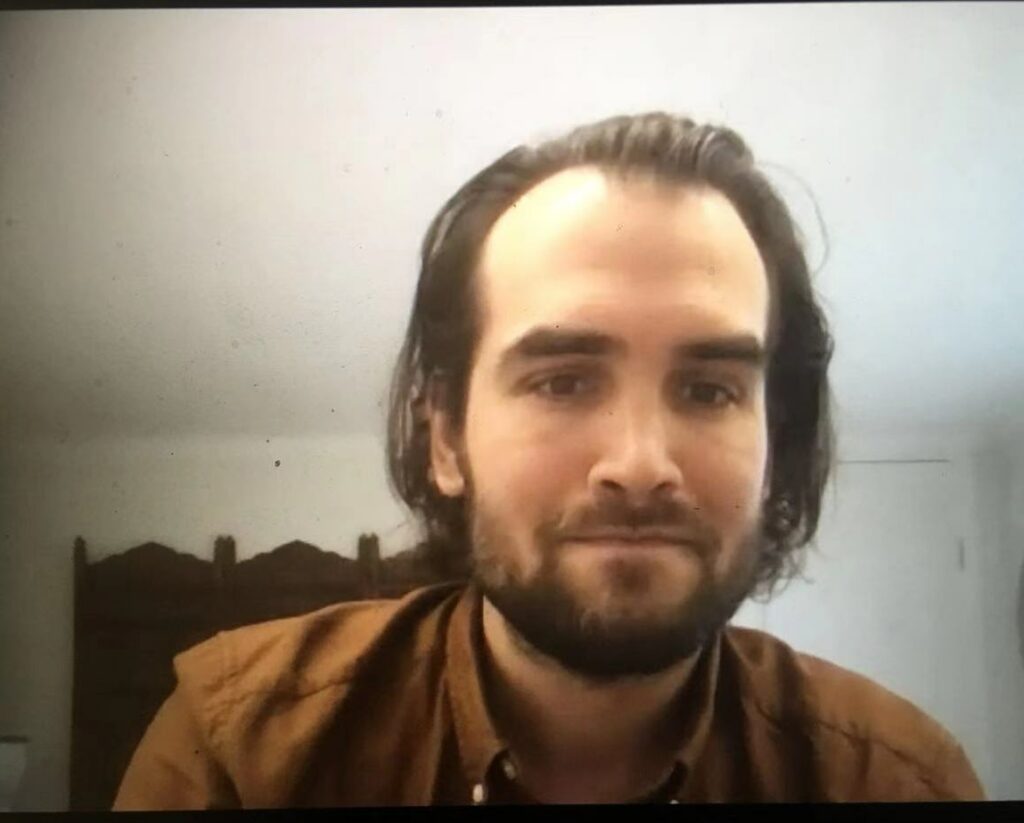
埃里克.费恩霍姆对本网记者说,他的基金会与来自包括哈佛大学的著名心理学家们合作,为瑞典政府雇员提供精神健康培训。
据统计,近年来心理和精神健康问题明显。过去每十人中有一个有心理健康问题,但是,现在,这个比例已经增加到10人里有三个人了。据费恩霍姆介绍,人们心理有问题的话,表现在精神有压力,精神不集中,工作时间不能长,积极性主动性都比较差,而且睡眠问题更严重,过去只有9% 的人有睡眠混乱的状况,现在已经有37%的人有睡眠问题。因此,可以说形势很严峻。这种状况因为新冠肺炎的泛滥显得尤其严重。
他说,这个问题也不光是在瑞典严重,在美国,有调查显示,疫情使感染者中三分之一的人都有精神健康问题。在意大利和中国也都有这种情况,人们精神压力大,抑郁等等。
在瑞典秋冬时间天黑夜长,白天经常阴雨连绵,本身就可能造成人心理抑郁,加上新冠肺炎更让人有焦虑和恐惧的感觉。
因此,29K基金会开始提供这种培训。费恩霍姆说他们的培训是线上进行的。每个被培训的员工都可以在手机上装上这种软件。在两个月的时间里,平均每周加起来只有不到两个小时的培训,其中包括一次45分钟的谈话,其他时间只要完成一些小节目就可以。
通过这样的培训,产生了一种互相关爱,互相帮助的环境,彼此增加了信任,人们可以畅谈自己的忧虑,自己的问题。通常人们是不愿意谈这个问题的。但是,通过手机软件互动,谈论这个问题,结果是很有效果的,对心理健康很好。
通过培训,人们有了处理各种关系的信心和能力,不管是家庭关系,还是和同事的关系,都大有改善。这样,人们的积极性和主动性就会变得更好一些。对工作和生活都有好处。
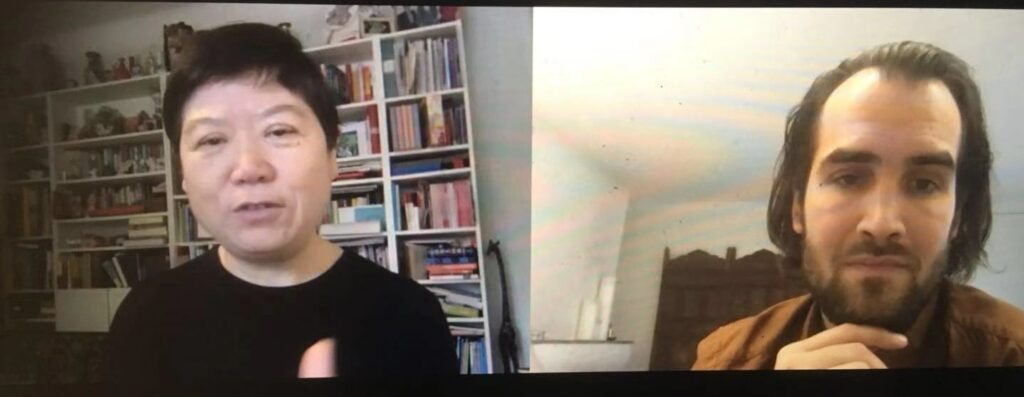
这种培训可以起到一种预防作用。费恩霍姆说,如果有的员工真的有精神健康疾病,严重的不能光靠这种培训,还是需要到医院接受正规医疗的救治。但是,医院的治疗是小范围的,一对一的。这个培训可以大规模培训,让成百上千人受益。
这对社会将会有很大好处。对雇员,公司都有好处。
当问及政府企业是否真的愿意为此买单时,费恩霍姆说,瑞典有工会组织,有社会合作伙伴,他们都强调这方面培训的重要性。瑞典政府也不把这个培训当作是一种耗费,而是当作一种投资,因为投资员工精神健康对政府来说是省钱而不是费钱。在瑞典的工作环境法里边对精神健康问题和工作环境都有相关规定。
如果有员工有精神健康问题,有可能平均给政府造成50万克朗的损失。而这个投入远远低于员工因精神或心理健康造成的损失。因为一旦有精神健康问题,最明显的表现就是要请病假。那样的话,政府不但要照发工资,还要找替代人员,所以往往需要双倍工资的支出。因此耗费巨大。
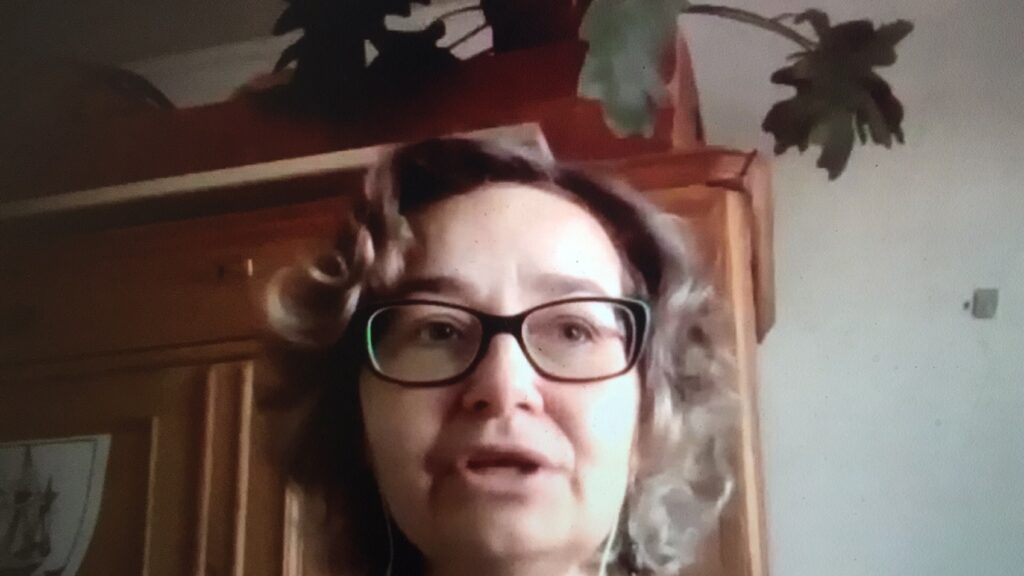
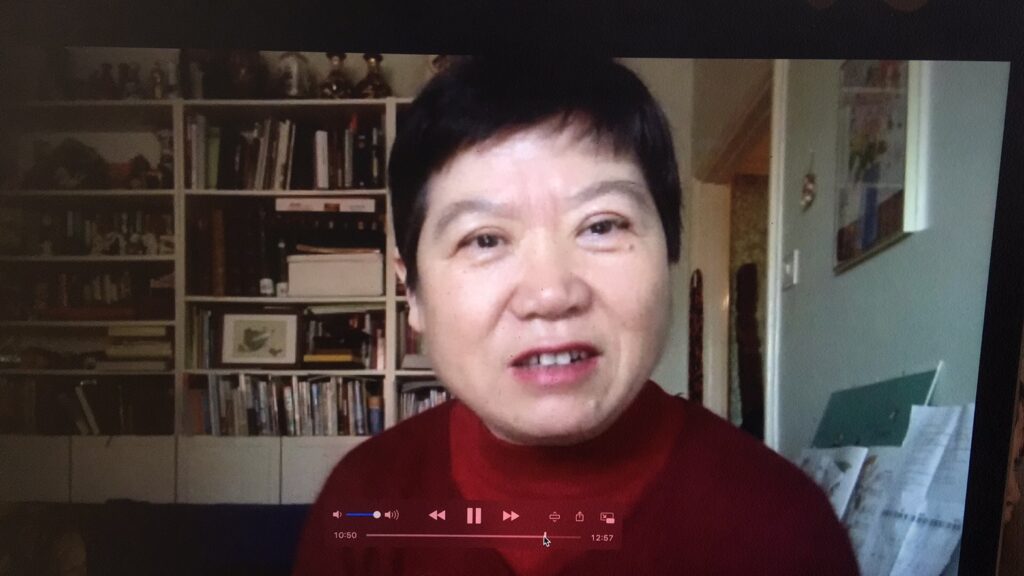
卞卡.雷迪(上图左)在瑞典世界文化博物馆工作,包括东方博物馆,地中海博物馆和少数民族博物馆。她负责展览策划工作。前一段时间大病康复不久就回来上班。正赶上新冠,不得不在家里工作。她参加了29K基金会的首期试验培训中的四个成员之一。她在视频采访中国对记者(上图右)说,她觉得这种线上培训效果很好。人们通过软件视频聊天,有主持人引导他们讨论相关话题,在有限的时间内,他们谈了工作,自己的感受,和家人的关系等等。通过这种谈话,她感觉好多了。
雷迪说,说句实在话,就是在现代社会,人们的信息太多,应该勇于说“不”。同时,也不要给自己设立过高的目标,要现实一些。对自己关爱一些。就会感觉好一些。这个培训真的改善了她的精神状态,提高了她的抗压能力。
费恩霍姆说,他们也想把这个培训方案传播到其他需要的国家。
费恩霍姆本人学习的是新兴交叉学科神经病学与幸福指数方面的研究。他说,29K指的是人生在世大约29000天,约合80多年。
请继续关注北欧绿色邮报网。将继续为您报道关于什么是幸福的问题。
By Xuefei Chen Axelsson
STOCKHOLM, May 10, (Greenpost) — Swedish Radio and Aftonbladet reported on May 6 that Swedish Customs had tested the Chinese traditional herb content medicine Lianhuaqingwen which they confiscated and gave a conclusion that the medicine doesn’t function and only contains mint in it.
This report was spread to China and Chinese medical academicians and relevant organisations immediately reacted on this news saying that the Swedish conclusion was not right.
The news said Swedish official in Drugs Administration lab said he didn’t find enough evidence to show the medicine is useful because he only found mint in it, but didn’t mention anything else and claimed that there was no any relevant articles about it.
This conclusion shows that he didn’t find the article about Lianhuaqingwen, nor read it. He neither found nothing else in the medicine or he found something but he didn’t know what they were.
News from Chinese Dr. Li said in fact there were 13 ingredients or components in the medicine. But only mint has a well recognised chemical format while the other Chinese herbs didn’t have chemical format.
The 13 ingredients are Lianqiao which is Forsythoside E, Jinyinhua which is honeysukle, similar to dandelion, luding, Rutin, mahuang, dahuang, which is Epherdra, bitter apricot core, plaster, banlangen which is a well-known antivirus medicine in China. Banlangen was invented in mid 1990s. I remember once I was asked to translate the specifications of the medicine because my radio people were often asked to do this kind of translation job. But I refused to do it because I felt I knew so little about medicine knowledge. But over the years Banlangen has become a daily medicine like Alvedon in Sweden. If people have virus type of flu, people can take Banlangen. If they have bacteria type of cold, they can just take the ganmaochonji a kind of small particle type of powder and just putting it into a cup of hot water and drink it.
Mianmaguanzhong, I do not know what it is, but Yuxingcao is also a well known name in dealing with eyes, Huoxiang is also a very common but well effective Chinese medicine. Hongjingtian is produced in Tibet and famous for its function to help you to have enough oxegon. When we were in Tibet, a colleague felt he was lack of oxegon, he went to buy oxegon bottle and Hongjingtian. Gancao was also a Chinese medicine both in tablet form or in raw herb form. One can swallow tablet, but drink water which soaks the gancao herb. The last one is exactly mint.
Mint is indeed a good component for various kinds of Chinese medicine. Mint sugar in Lidl actually helps you if you have a sore throat.
Academician Zhong Nanshan who was the key person in leading the campaign against Covid-19. President Xi Jinping was leading the campaign by sending hospitals, doctors and nurses and all the supplies through various provinces, Zhong Nanshan was a symbol of technical part, a lot of information was sent out through Zhongs name. Academician Zhang Boli who has retired at home, but he was summoned to lead in the campaign with his rich Chinese medicine knowledge. They both are authoritative while Zhong was in western medicine and Zhang was in Chinese medicine. But both recommended Lianhuaqingwen. During China’s campaign against covid-19, it was a perfect example of cooperation and combination of Chinese and western medicines.
Let’s look at the corona virus again. It is a virus, but the symptom when people catch it is coughing, fever, running or drying nose and fatigue. Thus the symptom is similar to a serious cold. Only when people are either too weak or too healthy to fight against the virus with no strength or too much strength, fiercely, then it hurt your organs especially the lung. The most typical symptom in the end is respiratory problem. But at the beginning, you just got a cold.
And all these components or ingredients of Lianhuaqingwen are useful in fighting against cold. Thus it can almost be treated as a most powerful kind of medicine in treating cold.
According to a joint study by researchers in Nanjing Chinese Medicine University and Shanghai Drug Research Institute under the Chinese Academy of Sciences, Lianhuaqingwen is so far the most functional medicine in inhibiting corona virus from reproduction and curing the fever of the patients.
According to Professor Fang Bangjiang from Longhua Hospital of Shanghai Chinese Medicine University, there were only 20-30 percent of the patients have fever. Most of them did not have fever. He was sent to Leishenshan Hospital China built within ten days after the closedown of Wuhan on January 23. ( link http://www.greenpost.se/2020/05/02/%e9%9b%b7%e7%a5%9e%e5%b1%b1%e6%8a%97%e7%96%ab%e4%b8%93%e5%ae%b6%e6%96%b9%e9%82%a6%e6%b1%9f%e6%95%99%e6%8e%88%e7%9b%b4%e6%92%ad%e4%b8%8e%e7%91%9e%e5%85%b8%e3%80%81%e7%be%8e%e3%80%81%e5%8a%a0%e3%80%81/)
Fang was in charge of a unit which had 108 patients who had light symptoms. He found that the patients had one unified symptom, that was panic and fear, worries and weak nerves. After trying western medicine for one week, he found it not only did not give positive results but give negative effects on liver. Thus he prescribed all the time Chinese medicine after a week. The Chinese medicine mainly calmed down the patients, relieved them from panic feelings and got them sleep better.
As a result, no one became more serious and no death happened in his unit. In comparison, those who were treated with western way or medicine, a lot of them could become worse and were sent to ICU.
According to the research paper, Lianhuaqingwen was used for severe patients too and by alleviating their fever or other symptoms, lives were rescued.
But so far, experts admit that there were no cure all kind of medicine against covid-19. But as a supportive medicine or healthy product, those who are confirmed to get covid-19 positive, they can take Lianhuaqingwen. Whether it works or not, one can feel it after three days. If after three days it did not function, you feel worse, then you must call the doctor again.
Sweden has tried its best to deal with the covid-19 and avoided the problem China had at the beginning of getting the hospital too crowded and almost collapse. Sweden wanted to let the covid-19 happen slowly, which is a good idea.
However, the virus loves people and can quickly spread from one person to two persons if you have close contacts, for example in crowds, not necessarily to kiss each other. It can spread through spit and sneeze or cough. But if people keep themselves isolated, the virus couldn’t find another person to reproduce itself, it will die with the recovery of the person. Thus isolation is very very important.
The earlier, quicker to isolate, the better. For example, if Swedish cancelled the travel, canceled the Eurovision, canceled the birthday party, and isolated quicker and earlier in other areas where you just found a couple of cases, then the virus probably got wiped out by now. But no one knows. Maybe it would take two to three months any way.
Thanks to Swedish people who are good at keeping social distance and mostly follow the government instructions, Swedish people did not sacrifice too much freedom and the society continues to function, which can be seen as a positive aspect. But if people especially those who got infected, but not to the extend to go to hospitals intensive care, maybe if they take the Lianhuaqingwen, it can not only comfort them, but also prevent them from getting worse.
To say it just got mint in it and does not function, it sounds like it is just the mint candy. But it is simply not true.
In fact, Lianhuaqingwen was just one of the Chinese medicines that dealt with covid-19. I guess it became famous because of its mass production and packaging. Qingfei Paidu Tang or Lung cleaning and poison eradicating syrup was also very popular during covid 19 campaign in Wuhan, Central China. But this kind of medicine is pure herb and needs to be boiled each time for each person. It is hard to get mass production. Chinese doctors also stressed that it was one person with his or her own prescription according to his or her own symptom.
Chinese medicine does not stress killing the virus or fighting the virus, instead, it stressed that the medicine helps patients to get stronger in immune system and physical strength by getting rid of or alleviating the symptom.
Covid-19 is indeed a strong virus which is very hard to deal with because it reproduces itself so quickly once it entered humans body and attacked the lung. By fighting back with the immune system, patients other organs such as liver or heart or kidney could be damaged too. That was why a lot of people died of not only virus, but also several other combined diseases. The virus can damage your immune system. Thus, the Chinese doctors emphasized that people should eat enough protein and sleep well. Getting yourself strong is the key to deal with the covid 19.
The following is the research paper about Lianhuaqingwen.

Available online 20 March 2020, 104761In Press, Journal Pre-proofWhat are Journal Pre-proof articles?

Author links open overlay panelLiRunfenga1HouYunlonge1HuangJichengd1PanWeiqia1MaQinhaiaShiYongxiadLiChufangaZhaoJinaJiaZhenhuaeJiangHaimingaZhengKuidHuangShuxiangdDaiJundLiXiaobodHouXiaotaocWangLincZhongNanshanaYangZifengabcShow morehttps://doi.org/10.1016/j.phrs.2020.104761Get rights and content
Lianhuaqingwen (LH) as traditional Chinese medicine (TCM) formula has been used to treat influenza and exerted broad-spectrum antiviral effects on a series of influenza viruses and immune regulatory effects [1]. The goal of this study is to demonstrate the antiviral activity of LH against the novel SARS-CoV-2 virus and its potential effect in regulating host immune response.
The antiviral activity of LH against SARS-CoV-2 was assessed in Vero E6 cells using CPE and plaque reduction assay. The effect of LH on virion morphology was visualized under transmission electron microscope. Pro-inflammatory cytokine expression levels upon SARS-CoV-2 infection in Huh-7 cells were measured by real-time quantitative PCR assays.
LH significantly inhibited SARS-CoV-2 replication in Vero E6 cells and markedly reduced pro-inflammatory cytokines (TNF-α, IL-6, CCL-2/MCP-1 and CXCL-10/IP-10) production at the mRNA levels. Furthermore, LH treatment resulted in abnormal particle morphology of virion in cells.
LH significantly inhibits the SARS-COV-2 replication, affects virus morphology and exerts anti-inflammatory activity in vitro. These findings indicate that LH protects against the virus attack, making its use a novel strategy for controlling the COVID-19 disease.
LianhuaqingwencoronavirusSARS-CoV-2anti-inflammatory
Coronaviruses are a group of enveloped viruses named for their coronary appearance with positive single-stranded RNA genomes [2]. In addition to six known strains of coronaviruses that are infectious to humans, a novel coronavirus (SARS-CoV-2) was detected recently in Wuhan, China [3,4]. Like the other two highly pathogenic coronaviruses SARS-CoV and MERS-CoV, SARS-CoV-2 also caused severe respiratory illness and even death. Moreover, the population’s susceptibility to these highly pathogenic coronaviruses has contributed to large outbreaks and evolved into the public health events, highlighting the necessity to prepare for future reemergence or the novel emerging viruses [5].
Similar to SARS-CoV and MERS-CoV, SARS-CoV-2 is initiated by zoonotic transmission likely from bats and spreads rapidly among humans [6]. The basic reproduction number (R0) of person-to-person spread is about at 2.6, which means that the SARS-CoV-2 infected cases grow at an exponential rate. As of February 07, 2020, 57,620 cases of the SARS-CoV-2 have been reported in China, including 26,359 suspected cases, and a sustained increase is predictable. The initial patient cluster with confirmed SARS-CoV-2 infection was reported Wuhan pneumonia with unknown aetiology, which bore some resemblance to SARS-CoV and MERS-CoV infections and was associated with ICU admission and high mortality. Moreover, High concentrations of cytokines were recorded in plasma of patients requiring ICU admission, such as GCSF, IP10, MCP1, MIP1A, and TNFα, suggesting that the cytokine storm was associated with disease severity [7]. A retrospective clinical study indicated the risk of fatality among hospitalized cases at 4.3% in single-center case series of 138 hospitalized patients [8], and the infection fatality risk could be below 1% or even below 0.1% in a large number of undetected relatively mild infections [9]. However, It is challenging to judge the severity and predict the consequences with the information available so far. Since no specific antiviral treatment for COVID-19 is currently available, supportive cares, including symptomatic controls and prevention of complications remain the most critical therapeutic regimens, especially in preventing acute respiratory distress syndrome [10]. Although the control of SARS-CoV-2 still presents multiple challenges in the short term, more potent antiviral drugs are urgent to be developed [4].
At present, some drugs are effective in eliminating SARS-CoV-2 and improving symptoms. The most promising antiviral drug for SARS-CoV-2 is remdesivir that is currently under clinical development for the treatment of Ebola virus infection [11]. However, the efficacy and safety of remdesivir for SARS-CoV-2 pneumonia patients need to be assessed by further clinical trials. In addition, in the prevention and treatment of COVID-19, Tranditonal Chinese medicines have received broad adoption, especially in treating cases of mild symptoms [12]. Lianhuaqingwen (LH), a Chinese patent medicine composed of 13 herbs, has played a positive role in the treatment of SARS-CoV-2. A retrospective analysis of clinical records was conducted in the SARS-CoV-2 infected patients at Wuhan Ninth Hospital and CR & WISCO General Hospital. LH combination could significantly relieve cardinal symptoms and reduce the course of the COVID-19 [13], making it successively included in the Guideline for the Diagnosis and Treatment of Novel Coronavirus (2019-nCoV) Pneumonia (On Trials, the Fourth/Fifth/Sixth/Seventh Edition) issued by National Health Commission of the People’s Republic of China and also recommended by 20 provincial health commissions including Hubei, Beijing, and Shanghai as well as National Administration of Traditional Chinese Medicine for the treatment of COVID-19. Moreover, LH exerted broad-spectrum effects on a series of influenza viruses by inhibiting viral propagation and regulating immune function and achieved similar therapeutic effectiveness with Oseltamivir in reducing the course of H1N1 virus infection [1,14,15]. Notably, the anti-influenza activity of LH in infected mice might depend on the regulation of cytokines, particularly in cytokine storm associated cytokines, such as IP-10, MCP-1, MIP1A, and TNF-α [1]. In the present study, we evaluated the antiviral and anti-inflammatory efficiency of LH against a clinical isolate of SARS-CoV-2 from Guangzhou in vitro.
The African green monkey kidney epithelial (Vero E6) cells and the human hepatocellular carcinoma (Huh-7) cells were cultured in Dulbecco’s Modified Eagle’s medium (DMEM, Gibco, USA) supplemented with 10% fetal bovine serum (FBS) at 37 °C. A clinical isolated SARS-CoV-2 virus (Genebank accession no. MT123290.1) was propagated in Vero E6 cells, and viral titer was determined by 50% tissue culture infective dose (TCID50) according to the cytopathic effect by use of Reed-Muench method [17]. All the infection experiments were performed in a biosafety level-3 (BLS-3) laboratory.
LH capsule (Lot No.A2001108) was obtained from Yiling Pharmaceutical Co. Ltd. (Shijiazhuang, China). UPLC fingerprints of LH consist of 32 common peaks. 9 of 32 common peaks are identified. The similarities in 10 batches of LH Capsules samples were all above 0.96 (Supplementary Fig. 1). The black powder of raw material of LH was first dissolved in dimethyl sulfoxide (DMSO) to 240 mg/mL. After shaking for 30 min at room temperature, the LH solution was diluted with serum-free DMEM to 24 mg/mL as a stock solution and stored at −20 °C before using. Remdesivir was kindly provided by Prof. Jiancun Zhang from Guangzhou Institutes of Biomedicine and Health, Chinese Academy of Sciences and was dissolved in DMSO to 100 mM and stored at −20 °C before using. DMEM with 2% FBS was used as the dilution buffer in the follow-up experiments.
The cytotoxic effects of the LH on Vero E6 and Huh-7 cells were evaluated by Methyl Thiazolyl Tetrazolium (MTT) assay. Briefly, monolayers of Vero E6 cells and Huh-7 cells in 96-well plates were rinsed with phosphate-buffered saline (PBS) followed by incubation with indicated concentrations of LH. After 72 h, the cells were stained with MTT solution at 0.5 mg/mL for 4 h. The supernatants were then removed, and the formed formazan crystals were dissolved in 200 μL DMSO. The absorbance was measured at 490 nm using Multiskan Spectrum reader (Thermo Fisher, USA). The 50% cytotoxic concentration (CC50) was calculated by the GraphPad Prism 7.0 software.
The Vero E6 cell monolayers were grown in 96-well plates and inoculated with 100 TCID50 of coronavirus strains at 37 ̊C for 2 h. The inoculum was removed, and the cells were subsequently incubated with indicated concentrations of LH or the positive control remdesivir. Following the 72 h of incubation, the infected cells shown 100% CPE under the microscope. The percentage of CPE in LH-treated cells were recorded. The 50% inhibition concentration (IC50) of the virus-induced CPE by LH was calculated by the Reed-Muench method [17].
The Vero E6 cell monolayers in 6-well plates were infected with 50 plaque-forming units (PFU) of SARS-CoV-2 for 2 h at 37 °C. After incubation, the cell monolayers were covered with agar overlay (final concentration: 0.6% agar, 2% FBS, indicated concentrations of LH or remdesivir). The plates were then incubated for 48 h at 37 °C with 5% CO2. Subsequently, the agar overlays were removed, and the cell monolayer was fixed with 10% formalin, stained with 1% crystal violet, and then the plaques were counted and photographed.
The Huh-7 cell monolayers in 12-well plate were rinsed with PBS and then exposed to coronavirus at a multiplicity of infection (MOI) of 1 for 2 h at 37 °C. The inoculum was removed and replaced with the indicated concentrations of LH or mock-treated with DMEM supplemented with 2% FBS for subsequent 48 h incubation at 37 °C with 5% CO2. The cells were then harvested for RNA isolation and qPCR as described previously [16]. The primer and probe sequences used for analysis are listed in Supplementary Table 1. The relative mRNA expression was calculated using the 2-△△Ct method with GAPDH as an internal reference gene.
Monolayers of Vero E6 cells in 6-well plates were incubated with SARS-CoV-2 at a MOI of 0.001 for 2 h at 37 °C. The virus inoculum was then removed and replaced with DMEM medium supplemented with 2% FBS containing LH (600 μg/mL) or remdesivir (5 μM). At 48 h p.i., the cells were fixed, dehydrated and embedded as described previously [18]. Ultrathin sections (70 nm) of embedded cells were prepared, deposited onto Formvar-coated copper grids (200 mesh), stained with uranyl acetate and lead citrate, and then observed under JEM-1400 PLUS transmission electron microscopy (Japan Electron Optics Laboratory Co., Ltd., JEM-1400 PLUS).
Statistical analysis was performed using GraphPad Prism 7.0 software. The differences in mRNA expression levels of cytokines were compared using a one-way analysis of variance (ANOVA). Values of p < 0.05 was considered to be statistically significant.
The cell viability after LH or remdesivir treatment was determined by MTT assay in both Vero E6 and Huh-7 cells. LH showed unapparent cytotoxicity for both cell lines at concentrations up to 600 μg/mL (Fig. 1A, C). The positive control remdesivir showed no cytotoxicity to cells at a concentration of 50µM (Fig. 1B, D).

To investigate the antiviral effect of LH against SARS-CoV-2 virus, the Vero E6 cells were infected with 100 TCID50 of virus and incubated with LH at various concentrations for 72 h. As shown in Fig. 2A, LH inhibited the replication of SARS-CoV-2 virus with an IC50 value of 411.2 µg/mL by CPE assay (Fig. 2A). Meanwhile, treatment with LH following infection also had a dose-dependent inhibitory effect on plaque formation of the SARS-CoV-2 virus (Fig. 2C). We selected remdesivir as the positive control in our study and the results showed that remdesivir potently inhibited virus-induced CPE with an IC50 of 0.651 µM and a total plaque formation inhibition at 5 μM (Fig. 2B, C).

To further confirm the efficacy of LH in inhibiting SARS-CoV-2 virus replication in cells, we detected the viral particles in ultrathin sections of infected cells under electron microscopy. At 48 h p.i., viral particles were found in cytoplasm, intracellular vesicles, endoplasmic reticulum, and cell membrane and presented spherical crown-like appearance, which was typical coronavirus morphology (Fig. 3B, G). LH (600 μg/mL) and positive control remdesivir (5 μM) treatment resulted in a reduction of the number of virions compared with mock-treated infected cells (Fig. 3G–J). It was interesting to note that some virions in the surface of LH-treated cells presented spindle sharp which was in contrast to the typical spherical particles in the mock-treated cells (Fig. 3I).

To determine the effect of LH on the expression of cytokines and chemokines induced by SAR2-CoV-2, the mRNA expression levels of TNF-α, IL-6, CCL-2/MCP-1, and CXCL-10/IP-10 were detected and compared between the LH-treated and mock-treated Huh-7 cells. The results showed that the elevated expressions of these four cytokines were significantly inhibited by LH treatment in a concentration-dependent manner (Fig. 4).

Starting from December 2019, a pandemic of respiratory illness caused by a novel coronavirus named SARS-CoV-2 is sweeping the mainland of China. This virus has spread to several foreign countries, threatening to trigger a global outbreak. Several antiviral agents can be envisaged to control or prevent viral infections by antiviral assay in vitro [14,17]. However, the efficacy and safety of novel candidates need validations in vivo, even for those clinically approved medicines, which means that it will take months to years for clinical practices. At present, symptomatic and supportive treatments remain key to clinical practices. Thus, Traditional Chinese Medicines (TCM) carried both the antiviral effect and the symptomatic relief might bring more clinical benefits [12]. As a classical TCM prescription for respiratory diseases, LH is the only approved medicine in the treatment of SARS and influenza. After the outbreak of SARS-CoV-2, LH as a representative TCM prescription was recommended again in the latest Guideline for the Diagnosis and Treatment of Novel Coronavirus (2019-nCoV) Pneumonia issued by National Health Commission of the People’s Republic of China The purpose of this study was to demonstrate whether the therapeutic effects of LH on the COVID-19 targeting virus replication and immunological regulation as it did on the infection caused by influenza viruses.
Our previous study showed that LH exhibited in vitro anti-influenza activity with IC50 ranging from 200-2000 μg/mL [1]. Here we demonstrated that LH also has a comparable antiviral potency against the SARS-CoV-2 virus with an IC50 value of 411.2 μg/mL (Fig. 2). Transmission electron microscopy (TEM) has been a potent tool to observe virus entry, virus particle assembly, viral ultrastructure, and budding from the plasma membrane [17]. To understand the antiviral details of LH, EM pictures were taken from each group. Abundant virus particles assembled at the surface of membrane, cytoplasm, and plasma vesicles in the SARS-CoV-2 infected cells, decreased in the treatment of LH at 600ug/mL. Notably, slight deformation of virus particles was seen in the LH treatment, which required us to make further studies.
Highly pathogenic coronaviruses such as SARS-CoV and MERS-CoV cause fatal pneumonia, which is mainly associated with rapid virus replication, massive inflammatory cell infiltration and elevated proinflammatory cytokine/chemokine responses. Although the pathophysiology of fatal pneumonia caused by highly pathogenic coronaviruses has not been completely understood, accumulating evidence suggests that the cytokine storm plays a crucial role in causing fatal pneumonia [18]. Excessive amounts of proinflammatory cytokines were reported (e.g., IL-1β, IL-6, IL-12, IFN-γ, IP-10, and MCP-1) in the serum of SARS patients [18], similar in the serum of MERS patients [19]. Chaolin Huang et al. confirmed the occurrence of the cytokine storm in the COVID-19 patients in ICU rather than those in non-ICU patients [7]. Based on the excessive cytokines responses, Suxin Wan et al. claimed that IL-6 and IL-10 levels could be used as one of the bases for predicting the outcome and prognosis of the COVID-2019 [20]. In this study, host cells infected with HCoV-229E and SARS-COV-2 increased the cytokine release such as TNF-α, IL-6, CCL-2/MCP-1, and CXCL-10/IP-10, which was suppressed by LH in a dose-dependent manner. The change of cytokine profiles suggested that LH might have a potential effect on the inhibition of cytokine storm induced by SARS-COV-2, which also needed to be validated in vivo.
Since the launch of LH, it has been widely used as a broad spectrum of antiviral agent in the clinical practice, especially for various respiratory virus infections. Previous studies have shown that LH a broad spectrum of effects on a series of influenza viruses by interfering with both viral and host reactions. Although LH significantly relieved the clinical symptoms of the COVID-19, the underlying mechanism of antiviral effects on coronavirus, especially in the SARS-COV-2, was still elusive. In this study, we demonstrated that LH exerted its anti-coronavirus activity by inhibiting virus replication and reducing the cytokine release from host cells, which supported the clinical application of LH in combination with existing therapies to treat COVID-2019.
The study was funded by Beijing Municipal Science and Technology Commission NCP Emergency Project; Hebei Provincial Department of Science and Technology NCP prevention and control emergency scientific research project (Grant no. 20277708D); The Science research project of the Guangdong Province (Grant no. 2020B111110001); Daxing District Science and technology development projects (Grant no. KT202008013).
Download all supplementary files included with this articleHelp
The following are Supplementary data to this article:Download : Download Word document (183KB)Download : Download Word document (53KB)Download : Download zip file (342B)
[1]Y. Ding, et al.The Chinese prescription lianhuaqingwen capsule exerts anti-influenza activity through the inhibition of viral propagation and impacts immune functionBMC Complement Altern Med, 17 (1) (2017), p. 130CrossRefGoogle Scholar[2]T.S. Fung, D.X. LiuHuman Coronavirus: Host-Pathogen InteractionAnnu Rev Microbiol, 73 (2019), pp. 529-557CrossRefView Record in ScopusGoogle Scholar[3]A. Du ToitOutbreak of a novel coronavirusNat Rev Microbiol (2020)Google Scholar[4]W.G. Carlos, et al.Novel Wuhan (2019-nCoV) CoronavirusAm J Respir Crit Care Med (2020)Google Scholar[5]J. NkengasongChina’s response to a novel coronavirus stands in stark contrast to the 2002 SARS outbreak responseNat Med (2020)Google Scholar[6]P. Zhou, et al.A pneumonia outbreak associated with a new coronavirus of probable bat originNature (2020)Google Scholar[7]C. Huang, et al.Clinical features of patients infected with 2019 novel coronavirus in Wuhan, ChinaLancet (2020)Google Scholar[8]D. Wang, et al.Clinical Characteristics of 138 Hospitalized Patients With 2019 Novel Coronavirus-Infected Pneumonia in Wuhan, ChinaJAMA (2020)Google Scholar[9]P. Wu, et al.Real-time tentative assessment of the epidemiological characteristics of novel coronavirus infections in Wuhan, China, as at 22 January 2020Euro Surveill, 25 (3) (2020)Google Scholar[10]A. Zumla, et al.Coronaviruses – drug discovery and therapeutic optionsNat Rev Drug Discov, 15 (5) (2016), pp. 327-347CrossRefView Record in ScopusGoogle Scholar[11]S. Mulangu, et al.A Randomized, Controlled Trial of Ebola Virus Disease TherapeuticsN Engl J Med, 381 (24) (2019), pp. 2293-2303CrossRefView Record in ScopusGoogle Scholar[12]J.-l. Ren, A.-H. Zhang, X.-J. WangTraditional Chinese Medicine for COVID-19 TreatmentPharmacological Research (2020), p. 104743ArticleDownload PDFGoogle Scholar[13]K Yao, et al.Retrospective Clinical Analysis on Treatment of Novel Coronavirus-infected Pneumonia with Traditional Chinese Medicine Lianhua QingwenChinese Journal of Experimental Traditional Medical Formulae (2020), pp. 1-7CrossRefGoogle Scholar[14]H. LuDrug treatment options for the 2019-new coronavirus (2019-nCoV)Biosci Trends (2020)Google Scholar[15]Z.P. Duan, et al.Natural herbal medicine Lianhuaqingwen capsule anti-influenza A (H1N1) trial: a randomized, double blind, positive controlled clinical trialChin Med J (Engl), 124 (18) (2011), pp. 2925-2933View Record in ScopusGoogle Scholar[16]Z. Li, et al.Radix isatidis Polysaccharides Inhibit Influenza a Virus and Influenza A Virus-Induced Inflammation via Suppression of Host TLR3 Signaling In VitroMolecules, 22 (1) (2017)Google Scholar[17]M. Wang, et al.Remdesivir and chloroquine effectively inhibit the recently emerged novel coronavirus (2019-nCoV) in vitroCell Res (2020)Google Scholar[18]H.N. Leong, et al.Clinical and laboratory findings of SARS in SingaporeAnn Acad Med Singapore, 35 (5) (2006), pp. 332-339View Record in ScopusGoogle Scholar[19]A. Assiri, et al.Epidemiological, demographic, and clinical characteristics of 47 cases of Middle East respiratory syndrome coronavirus disease from Saudi Arabia: a descriptive studyLancet Infect Dis, 13 (9) (2013), pp. 752-761ArticleDownload PDFView Record in ScopusGoogle Scholar[20]S. Wan, et al.Characteristics of lymphocyte subsets and cytokines in peripheral blood of 123 hospitalized patients with 2019 novel coronavirus pneumonia (NCP)medRxiv (2020)p. 2020.02.10.20021832Google Scholar
By Xuefei Chen Axelsson
Stockholm, Feb. 22(Greenpost) — Today a news was spreading around the wechat circle. That was Academician Zhong Nanshan smiled. Dr. Zhong was considered as a hero in anti-SARS campaign in 2003 because he was one of the first who declared this was a serious epidemic and caused attention from the government.
Dr. Zhong Nanshan Smiles

This time Dr. Zhong was also the most authoritative voice saying that the corona virus could spread from person to person and at a faster speed.
When he was interviewed before, he was very serious and looked a bit tired and stressed. He almost cried when he was interviewed for the first time when he mentioned that Wuhan people sang the national song through the windows in the evening after the order was issued that Wuhan city was closed and all the people should stay at home.
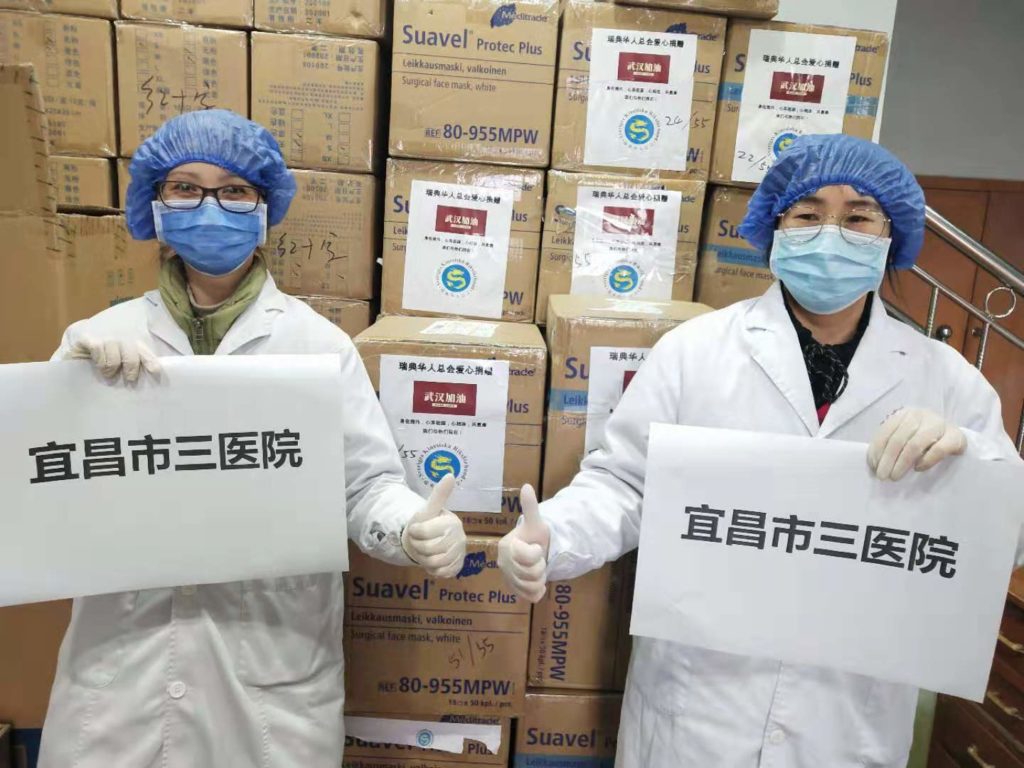
It was indeed very moving and respectful for Wuhan people because in front of the sudden attack of the virus and the determined order of closing a city which has a population of 14 million. It was not an easy decision because even after the decision, Wuhan Mayor Zhou Xingwang was still saying that this was historic and if anything wrong with it, he would like to shoulder the responsibility.
Some people thought he should have closed Wuhan even earlier, but it is indeed understandable that the decision needed scientific evaluation which took time and efforts.
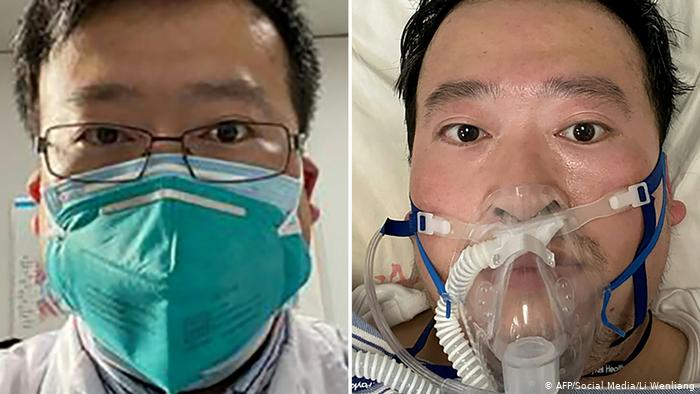
Dr. Zhong was 84 years old and he was very respectful. Both leaders and people really listen to him and thus a lot of notices were issued or advised with his name. But when mentioned Dr. Li Wenliang who first issued the news in his Wechat circle among friends and colleagues but got infected and died at age of 34, Dr. Zhong said Li was a hero and he should be respected too. At that moment, tears also sheded from his eyes.
But yesterday at a press conference in Guangzhou, he took off his mask and smiled. This smile implied a relief that the COVID-19 had been under control. The newly infected cases have decreased for a consecutive 16 days outside Hubei province. He did not say the turning point has come. He said Wuhan is still the heavily infected area. But the trend is in positive direction.
According to news from CDC China the newly diagnosed cases reached to 397 while the new death cases reached to 109 with accumulated cases reaching to 76288 and death toll 2345 and recovered cases 20659. Recovered number goes beyond 20 thousand.
Yesterday they also lifted observation for 26441 people. Accumulated close contacts were 618915 people and 113564 of them are still on observation.
Hubei has 366 newly diagnosed infected cases while 1767 cases were recovered yesterday. 106 people including 90 from Wuhan died. Total death accumulated to 2345 people.
47647 people in Hubei have been identified as infected and Hubei’s beds in hospital also almost reached 40 thousand. Thus those who are in need can possibly get a bed. 10892 people are severely infected. 13557 people have recovered and left hospital so far in Hubei province.
During the campaign against the COVID-19, Chinese medicine exerted a great role. Dr. Zhong Nanshan said Chinese medicine can exert a role in alleviating the symptom.
Many Chinese medicine doctors used many kinds of herbal medicine to clear the lung and improve the immune system so that the patients can have more strength to fight against the virus.
The theory is that Chinese medicine is used to improve patients’ immune systems while the western medicine theory is to combat the virus and reduce infections but the side effect is very serious.
Chinese medicine doctors even teach the patients to play Baduanjin, a kind of Taiji exercise. They treat each patient with personal treatment and the result was quite good. The Chinese medicine is used to treat the light infected patients and prevented them from getting worse.
China’s control of the COVID-19 is seen as effective because it avoided large scale infection around the world. By closing down the big city and controlling spread of virus, many people believe this could only be done in China under the leadership of the CPC. Chinese government under the leadership of President Xi and CPC have taken stronger measures to control the spreading with the leading role played by respected doctors and nurses and party members.
China has exerted its advantage and tradition of helping each other among all provinces, for example 16 provinces provided help with their capacity to Hubei province and overseas Chinese also gave donations of masks from the beginning to Hubei provinces hospitals. Two years ago when I was in Xinjiang, they said they were grateful for 19 brotherly provinces to support them. Now when Hubei suffers from COVID-19, sister areas in Xinjiang donated a lot of apples to Hubei showing the Chinese culture of helping each other when in need.
It is worthwhile to mention that there was one city in Hubei province closed its city a week earlier and the infection was substantially reduced. Sichuan province and Henan Province were also very strict in preventing the virus from spreading and very effective.
Zhejiang province got second most infections since it has close relations with Hubei province. But Zhejiang province took even more strict measures in controlling the spreading of the virus and put it under control sooner.

So far, many provinces have resumed production and workers in western China were sent back to eastern regions with chartered airplanes or chartered fast trains since the traffic became rare during the Chinese Spring Festival.
Many Chinese said this spring festival was very special, but it was also normal because this year all the families must stay at home and children don’t need to go back to school so soon.
Many feel panic and worried while many others use the chance to study or do something more interesting in addition to dance and exercise at home.
With Wechat, people can share information and encourage each other or help each other.
Chinese humor also appeared during the anti virus campaign. For example love was sent through the message and the answer can be “lets not meet now.”
One of humor was very interesting and here I translated it as the following:
Wuhan has made eight contributions to the world:
In addition, writers, artists and educators are also working at home. Many teachers began online teaching or live broadcast. Many home business started and many innovative ideas came out and actions taken at home with internet.
During the campaign, postmen were very busy and they job quardruppled. Many restaurants were severely affected, but the fast food somewhat better survived.
During the first week people relied on their stored food for the week long spring festival. But after two weeks, people have to go out to buy food and in some area, the practice was that every three days one family can send out one person to buy all the groceries.
The market supply is still there and many provinces donated things they have such as vegetables, apples, cabbage and rice. At beginning, Wuhan gave the vegetables to the market, but after the donor questioned about it, people stopped that action, but it also appeared that the vegetables got rotten because short of personnel to deliver it. Thus, I think it is not a bad idea to send these vegetables to the market sellers either donate or with low cost. Because it is hard for the Red Cross to redistribute these vegetables to every family or hospital or other units. Let market function is not a bad idea.
During the first week, it was somewhat panic because all over the world, the overseas Chinese said they donated goods, but due to the closedown of traffic and many countries stopped airlines, it took longer time for the good to arrive in Wuhan or Hubei, some took two or three weeks.
Due to the panic mentality, there have been some episodes of the news or communication driven by social media to lead to people’s sadness such as Dr. Li Wenliang’s death, the poetic and friendship words on donation packages from Japan aroused a big discussion. Some people said the Japanese are more educated than Chinese who only know to say Cheer up Hubei, Wuhan, or God Bless China. But as more patients were cured and more hospitals were built, the desperate mentality has been cured.
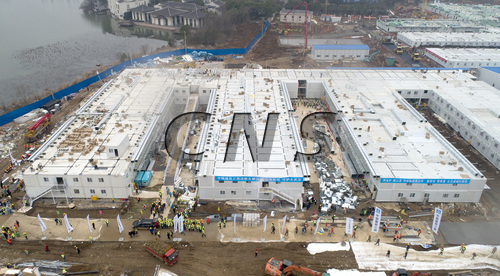
At the very beginning, China also stunned the world by building a Huoshenshan hospital and a Leishenshan hospital by about ten days. Huoshenshan means God of fire mountain and Leishenshan means God of thunder mountain. The hope is that the fire and thunder will definitely kill the virus with their power or magic working like holy spirits.
In addition to two new hospitals, many Noah Ark like hospitals were also built to host more than 40 thousand patients infected by COVID-19.
It seemed to me that in China, with the leadership of the Chinese Communist Party and its 89 million party members, the government gives orders, the enterprises cooperate in keeping supply lines and the society echoed all the calls. So the government, enterprises and society united much better than normal times in front of the disasters.
In this sense, I would like to give the credit to the party members because while in dangerous situation, it was always the party members should step forward and face the danger first.
For example, during this anti virus campaign, over 30 thousand doctors and nurses voluntarily answered the call and went to Wuhan to work in those new hospitals. Most of them are party members and many of them who are not would like to join the party on site. This spirit was really moving.
According to reports, due to the uncertainty before the closedown of Wuhan and later with overload of work and stress, by February 11, 3019 doctors and nurses were infected by COVID-19 virus and 1716 cases were confirmed. Among them, 1502 cases were from Hubei province.
During this campaign, nine doctors including two professor doctors, one hospital president died at work. They have become a martyr for us all.
Yesterday I watched the Oct. 18 201 event simulation meeting organized by Johns Hopkins Health Security Center, World Economic Forum and Bill and Melanda Gates Foundation which discussed a lot about how to deal with such kind of serious virus epidemic or pandemic. This show actually caused a lot of conspiracy views which thought America has known this. But I think the discussion mainly focuses on a scenario that the government and business are difficult to form a partnership and the individualism ideas make people difficult to follow the information or guidance.
Indeed there were many rumours and fake news coming out mainly from anti China chinese in America. For example they smear the Wuhan P4 lab for leaking the virus. But as I interviewed Professor Duan from Karolinska Hospital, it is impossible to a P4 lab to leak anything out. It is a very scientifically built lab which has negative pressure which guarantee for the security. As for the scientists, it is also impossible for scientists to have such a low level ethics or break their ethical bottom line.
Some Chinese in America who suffered a setback during Chinas anti corruption campaign or Falungong related people, they only spread their hatrad, presumptions or fabrications plus their imaginations.
It is not difficult to imagine that Chinese hospitals would be extremely busy even during the normal time, let alone under the current situation.
In my opinion, Chinese system is actually functioning well because it is more centralized and the government answered the call of the people quickly and whole heartedly. Under the principle of putting the people’s lives in the center, Chinese economy is definitely affected.
But I think just because it is Spring Festival time, many production stopped anyway, the most damaged industry is tourism and restaurants and hotels. Thus, this effect is felt not only in China, but also many other countries including nordic countries such as Sweden and Finland.
Now since the virus is somewhat under control, it was reported that about 95 percent of production business began to resume.
For example, workers from Xinjiang were sent to Hunan by chartered airplanes with preventive measures. Slowly workers are on the working places now. So far only the students are still at home to enjoy their holidays.
Nowadays schools open earlier than 30 years ago when I was at university. Then the opening of schools was on March first. Nowadays it was usually after the Spring Festival holiday. Due to COVID-19, students can relax a little bit.
Finally about the COVID-19, it is a new kind of virus which was similar to SARS or MERs but not as deadly as those, but it spread faster. It can also spread to other people before you really have symptoms such as coughing, fever and fatigue. Those who are over 80 years old, the infection rate is 14.8%. The younger people are less likely infected. Those who died are mostly having other diseases such as cardiological problems, diabetes and high blood pressure.
The main prevention method is to isolate yourself, often wash your hand, don’t touch your face. It can spread by sneeze or spit. So Dr. Zhong adviced people to even pay attention to your shoes. Try to avoid stepping on any spit.
Where in the world comes the virus from?
So far it is still not clear where the virus comes from. According to early first seven cases, four persons came from a seafood and wildlife trading market, but three others didn’t come from there. The latest research from Yunnan branch of the Chinese Academy of Sciences shows that the virus does not come from that market because their samples show that it is the same as the other three.
Some people suspect that this virus might be the same as the American flu, or another version of the American flu.
But to be honest, no one knows where and when exactly it came from. It can be estimated that the very first spreading of the virus can be on November 27th. Someone said it might start on mid October, but due to the favorable climate, it didn’t break then. Due to the shrewdness of the virus, it can have longer incubation period of 24 days.
Maybe the cold and wet weather in Wuhan just provides the bed for the virus, it is hard to say. We have to wait and see how the scientists and researchers find out through autopsy and sample studies.
Text by Xuefei Chen Axelsson. Photos from web.
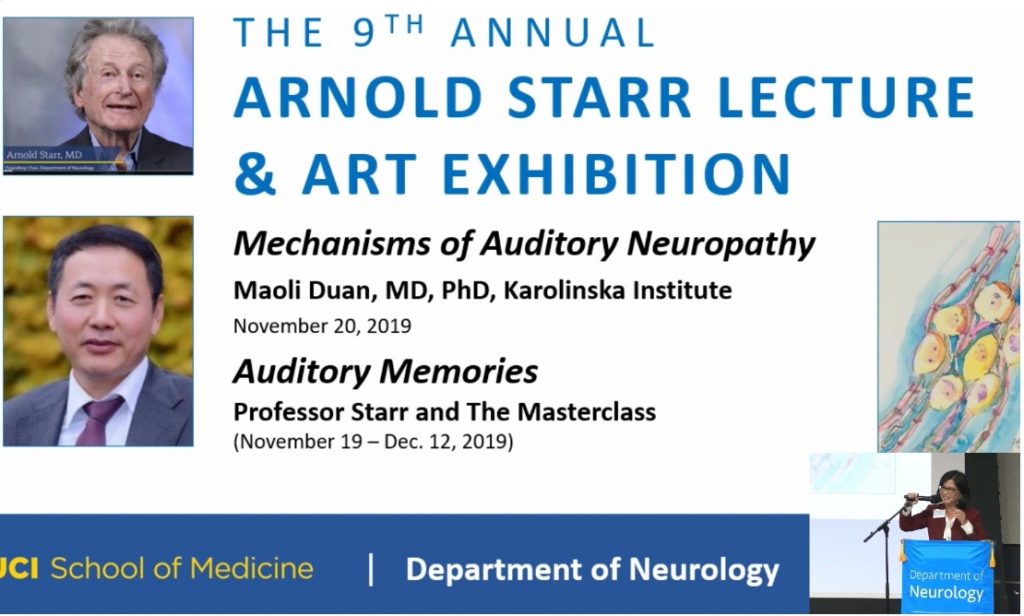
北欧绿色邮报网、北欧中华网联合报道(记者陈雪霏 查正富)—11月20日,应世界听神经病鼻祖-美国加州大学Arnold Starr教授的邀请,瑞典皇家卡罗林斯卡Karolinska医科大学医院耳鼻咽喉头颈外科专家段茂利出席了第九届 “Annual Arnold Starr Lecture & Art Exhibition”大会,并做了题为《听神经病的发现历史、发病机制、治疗现状及基因/干细胞治疗听神经病的探索》的精彩报告。这是目前世界上首位华人科学家站在此领域最高讲台作学术报告,刷新了听神经病领域未有华人科学家在此登台“献艺”的空白。
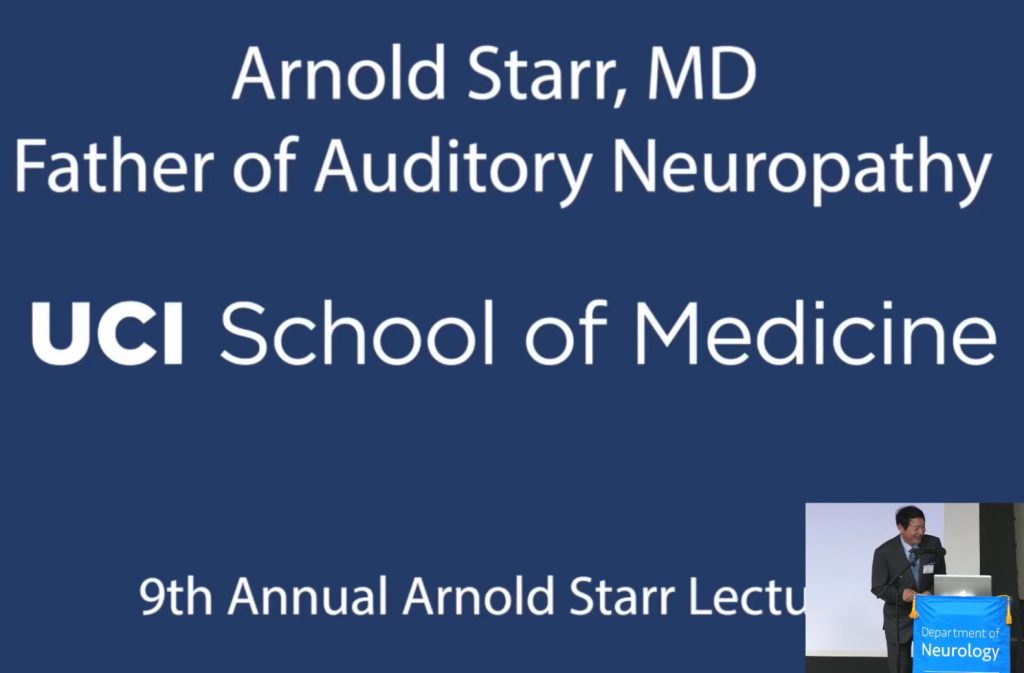
世界听神经病大会每年举办一次,由听神经病之父Arnold Starr教授命名,其突出特点与其他学术会议不同的是,此会议只安排一位科学家作主旨报告,因此入选的条件和门槛要求很高。大会筹委会对照规定的标准和条件,综合各方面因素,每年在全球范围内精选出一位杰出的听神经病、神经科学及耳鼻咽喉科学家作主旨报告。今年段茂利教授有幸作为第九届会议报告嘉宾登台作主旨演讲。
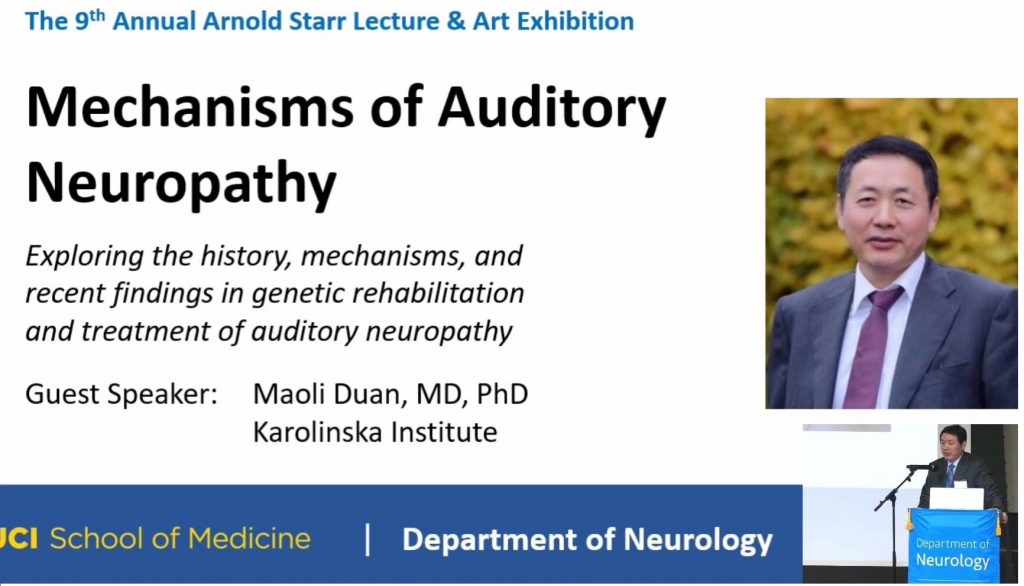
演讲伊始,段教授简单地介绍了其所工作的瑞典皇家卡罗林斯卡大学医院的基本情况。新建成的卡罗林斯卡大学医院工程造价超过600多亿瑞典克朗,是目前世界上最节能、最环保的建筑楼群,拥有最现代化的基础设施和智能工程,很多岗位已由机器人代替了人工操作。每年举世闻名的诺贝尔生理或医学奖的评审和颁奖,均由瑞典卡罗林斯卡医科大学负责组织实施。
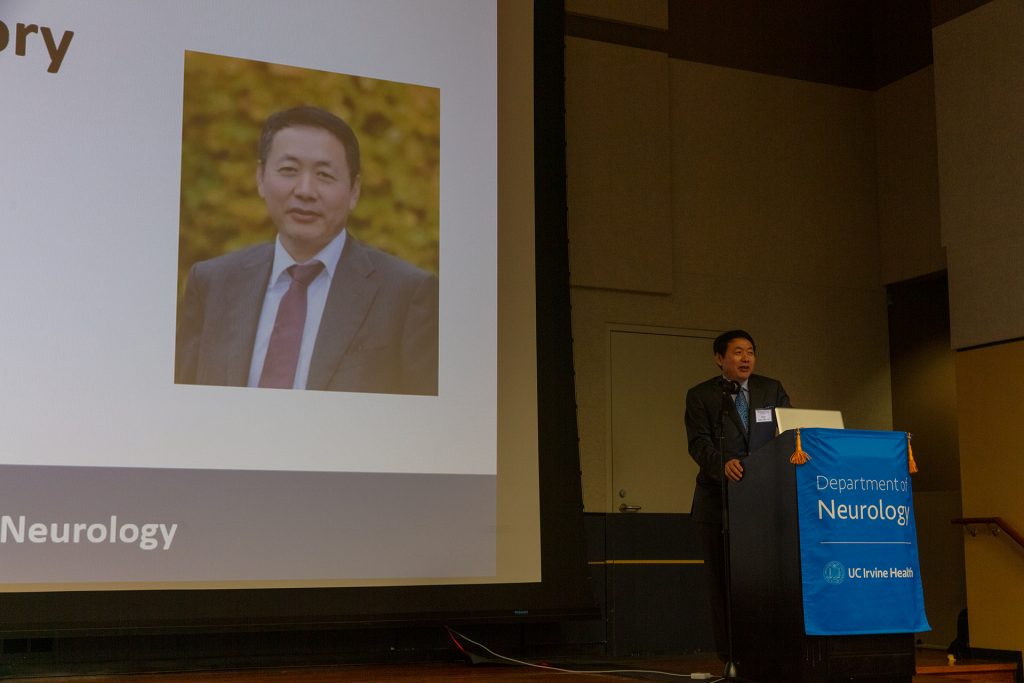
演讲期间,段茂利教授从Arnold Starr教授绘制的不同奇妙耳科彩色图画入题,以“弹钢琴”作为比喻,通过科学研究与艺术表现相结合形式,形象生动地描述了如何通过各种颜色来观察耳部结构和接受声音时的变化规律,详细阐述了常规听神经病变、特殊听神经病变和其他情况的修复和临床治疗方法。整场报告条理分明、论点鲜明、论据充分、观念新颖,得到了与会嘉宾一致肯定,赢得了热烈的掌声 。


段茂利教授回到斯德哥尔摩当天,北欧绿色邮报网、北欧中华网报记者在第一时间对他进行了专访。以下是专访内容:
记者:段教授您好!欣悉您这次参加第九届“Annual Arnold Starr Lecture & Art Exhibition” 大会并作主旨演讲,我们已仔细观看了您当天演讲同步直播的全过程,非常精彩及惟妙惟肖,我们代表北欧绿色邮报网、北欧中华网对您表示祝贺! 请问这次国际会议在世界医学领域具有怎样的重要地位呢?
Dr Duan:谢谢!在听神经病研究领域,每年的Starr会议对于业内人士来说非常重要,世界各国的听神经病科学家也极为重视。Starr教授于1996年首次提出了听神经病这一医学概念。人的听力不好或下降,是因为耳朵里的某段神经出了问题,不能将听到的信息输送到大脑,从而大脑不能总结获得的信息,造成病人能听到声音但不能理解你到底在说什么。Starr教授通过对一名患者多年反复观察与追踪,并经过多年的潜心研究,发现并总结了这一问题。同时他还发现内毛细胞丢失也是病理机制之一,最终把这种病命名为听神经病。Starr理论提出后,在世界耳鼻咽喉头颈外科、神经科学领域引起了极大轰动,并得了国际医学界的一致认可。为了纪念Starr教授对人类作出的突出贡献,美国加州大学在Starr教授退休的时候,以其名字设立了基金会并决定在全球范围内,每年遴选一位在该领域成就突出的科学家做一次专题报告。今年我十分荣幸地被选中,这既是基金会对我个人的信任,也是对我多年来研究成果的认可,更是对我今后研究和临床工作的鼓励。
记者:Starr基金会为什么选择请您来做主旨报告呢?
Dr Duan:从客观上讲,可能是因为我长期在瑞典卡罗林斯卡大学医院工作,该院的国际地位和国际实力是众所周知的,加上我在基因干细胞研究领域的贡献及自身又是耳鼻咽喉头颈外科专家,同时我又是多个国际性医学杂志的编委及审稿人, 在欧美许多国家著名的大学演讲及交流的经历, 以及这么多年在行业积累的良好口碑,可能也是加分因素之一。从主观上讲,我在听神经病基因干细胞治疗耳聋方面的研究成果得到了国际同行的认可,尤其是创新研究了基因干细胞治疗耳聋,这一疗法既符合Starr教授的研究方向,也是对现有理论成果的进一步探索与挖掘。Starr教授发现了听神经病的一个基因后,医学界发现大量的同类疾病不同的基因。在该病发现之前,人们并不太清楚这种疾病发病的机制,而且在发现的早期,为解除病人痛苦,只是采用助听器进行辅助治疗,没有更科学的医疗手段。因此,我主攻的基因干细胞修复疗法既是学术研究的连续,更是为将来临床实践带来希望。当然,以上纯粹是我个人不成熟的推测,重要的是Starr基金会按照他们的标准和要求来进行挑选的。
记者:两年前Starr教授在斯德哥尔摩(Karolinska Nobel Forum)诺贝尔演讲厅的研讨会上用艺术彩色图形来展示耳部神经系统,您今年这次演讲似乎也很倾向艺术化啊!
Dr Duan:是的。参加这次大会的嘉宾中,他们大都是行业内有名望的科学家,在自身研究领域内取得了突出的成就,我在前面也已经介绍过了。但你们可能没有想到的是,这些嘉宾中很大一部分人也是艺术界的佼佼者,是名副其实的艺术家。因此,本次会议的名称除了第九届Starr学术会议主题外,另还冠名了艺术展览和艺术表演。因此,这次大会两个突出的与众不同之处就是:一是一个人做主旨演讲,另一个是学术报告与艺术同台展现。
记者:当初您为什么会选择耳鼻咽喉头颈外科呢?
Dr Duan:说起这个话题就很长了,在八十年代,大学生毕业的岗位是由组织统一安排的。我大学毕业后被分配到安徽省立医院耳鼻咽喉头颈外科工作,其实当时我对耳鼻咽喉头颈外科并不是十分感兴趣,觉得它是小科,我当时心仪的岗位是心脑血管科,但最终没能如愿。在耳鼻咽喉头颈外科岗位工作时间长了,我感觉到耳科研究很有趣味,人的耳朵其实是很美丽且复杂的,不是当初我想象的那么简单枯燥,后来我慢慢地热爱上了这个学科。其实人体的很多病症也都能从耳廓中体现出来,千万不要小看自己的耳朵、鼻子、咽喉甚至是牙齿。如果它们有不健康的症状,也是身体某个对应器官疾病的先兆,因此要引起足够的重视。中华医学博大精深,古代中医学家绘制的全身疾病在耳廓上的穴位图是中华医学发展的一块灿烂明珠。
记者:听您讲了这些,您在所在领域作出了突出贡献,您也培养出了30多名医学硕士、博士或博士后,您对现在年轻学生有什么经验之谈吗?
Dr Duan:谢谢!无论做什么事情,在哪个岗位工作,我认为最重要的一点就是兴趣,从事科学研究的也是一样。要时常怀有好奇心,一旦对某项东西感兴趣了,你就会拥有一种动力而深入研究下去。其二,从事科学研究要富有挑战精神,不能拘泥于现有,也不能完全迷信权威,要时刻有 “鸡蛋里挑骨头” 的韧性和 “打破沙锅问到底” 的执拗,敢于打破常规,勇于接受挑战,在挑战中创新,在逆境中突破,这样就会有新的发现。再者,要博览群书,只有积累了一定厚度的知识,研究中才能有力量支撑,才能容易打通瓶颈,做任何事情都要做到干一行爱一行,干一行精一行。
记者:谢谢段教授! 非常感谢您在百忙之中抽出时间接受我们的采访。
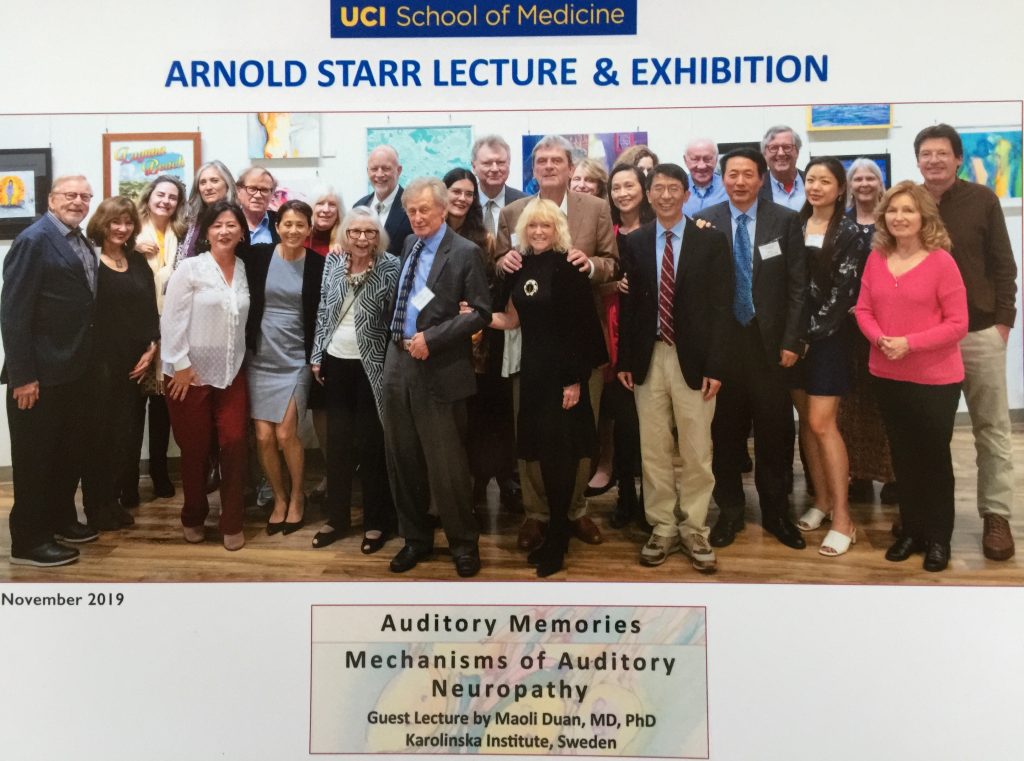
By Xuefei Chen Axelsson
STOCKHOLM, Nov. 20(Greenpost)– Ma Jianzhong, Chairman of World Federation of Chinese Medicine Societies (WFCMS) led a large delegation of over 30 members to visit Sweden in order to make academic exchanges and field study on November 13th.
This was right after they attended the 16th World Congress of Chinese Medicine which was successfully held in Budapest, Capital of Hungary. The delegation includes leading experts and specialists in the field of Chinese medicine.
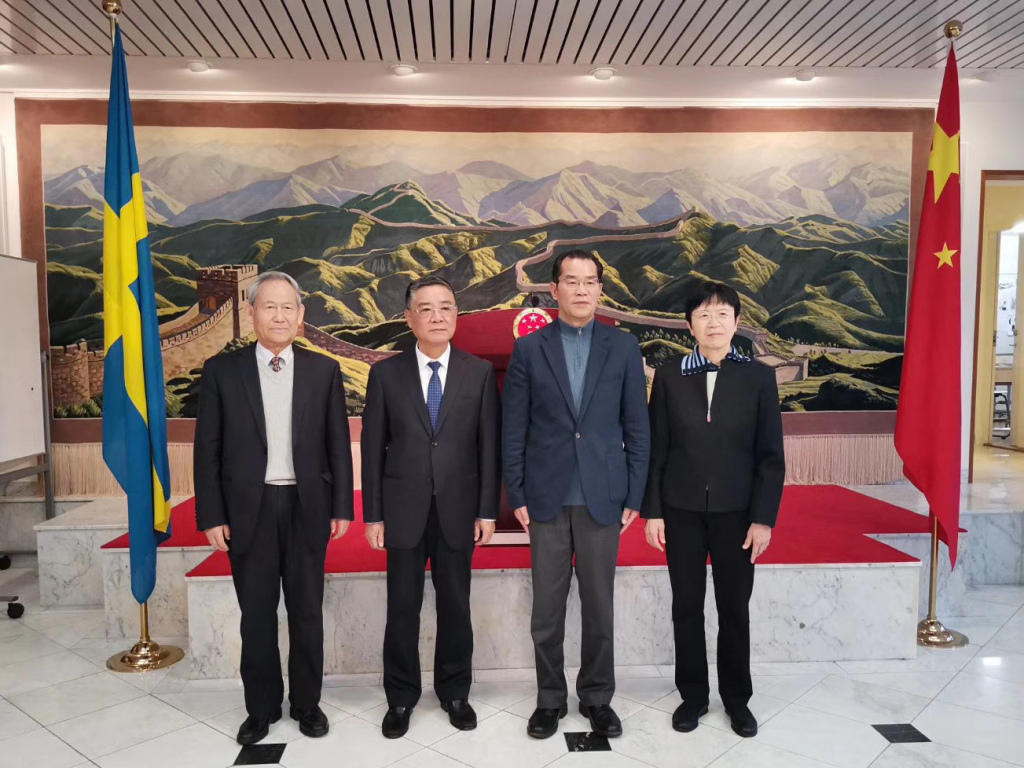
At 10:30 in the morning, Chairman Ma Jianzhong, former Vice Minister of Health, Professor She Jing, who was also founding Chairman of the World Federation of Chinese Medicine Societies, and Professor Li Zhenji, Vice founding Chairman and Secretary-General of WFCMS and other six people came to the Chinese Embassy in Stockholm at the invitation of Chinese Ambassador Gui Cuiyou.
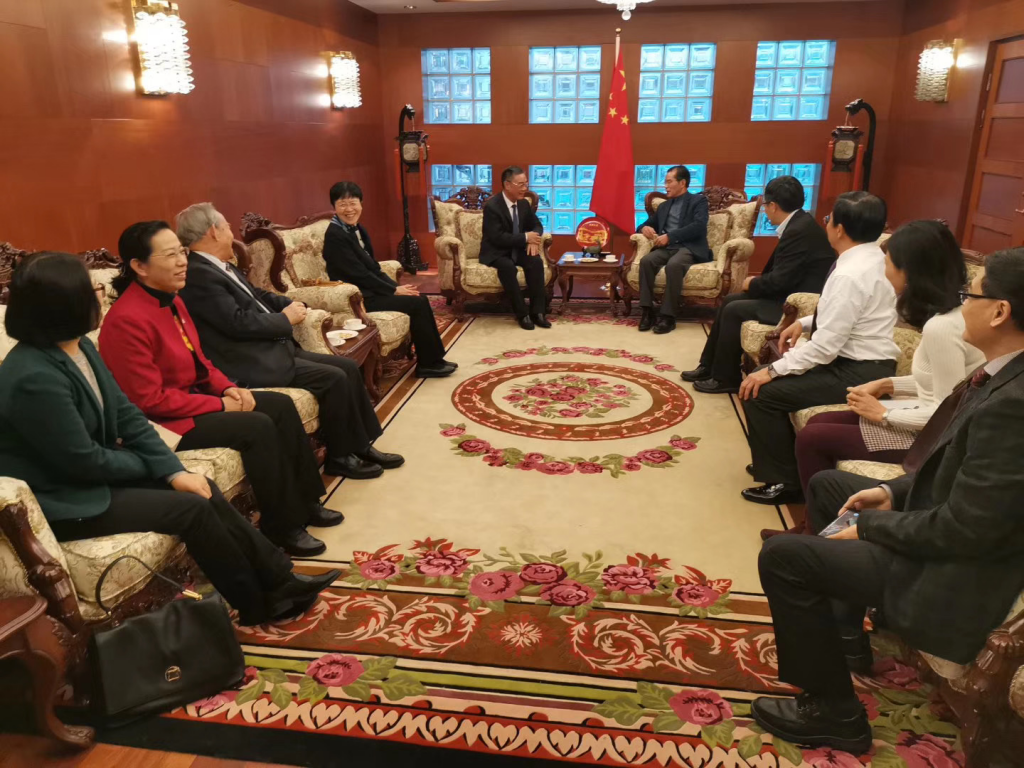
They were warmly welcomed and Ambassador Gui made extensive talks on the development of traditional Chinese medicine acupuncture and moxibustion in Sweden, and further explored how to further promote Chinese medicine culture and relieve the suffering of the Swedish people and overseas Chinese.
Counselor Dai Gang of Science and Technology at the Embassy and President Yang Chungui of the Swedish Society of Chinese Medicine gave a detailed introduction about the operation of Swedish traditional Chinese medicine and acupuncture clinics and the exchanges and cooperation with Western doctors such as those from Karolinska Hospital.
Jiemei, a lawyer at Guohao Law Firm, introduced the work of promoting acupuncture legislation in Sweden. After the talks, the Embassy arranged a lunch for all the guests.
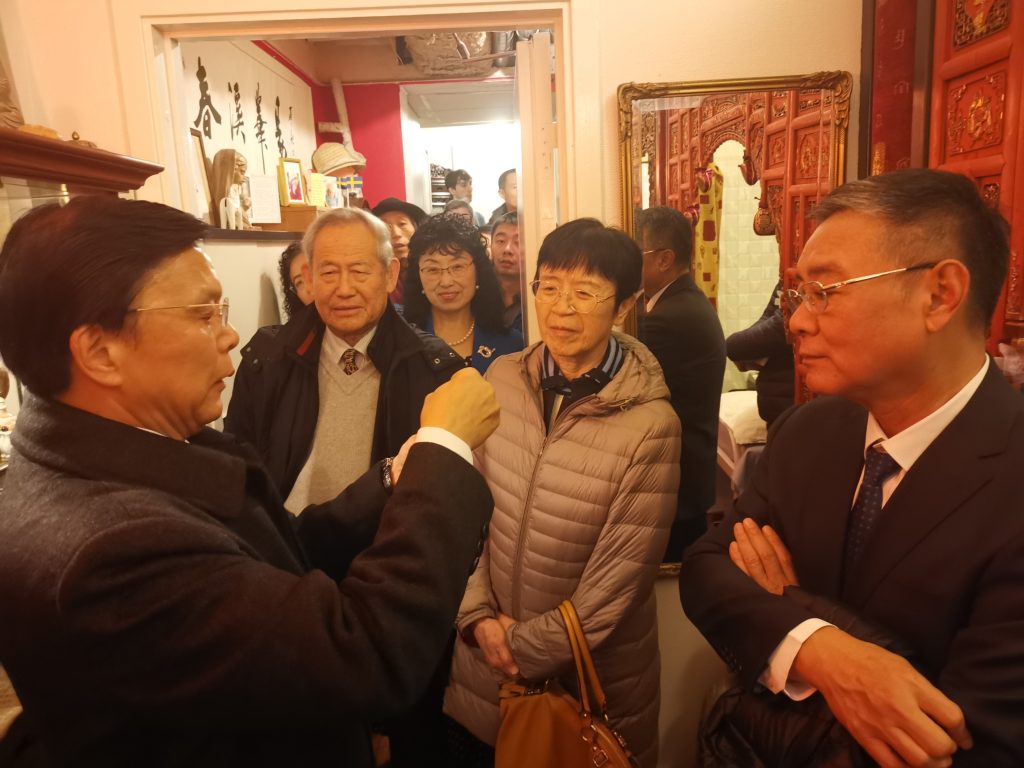
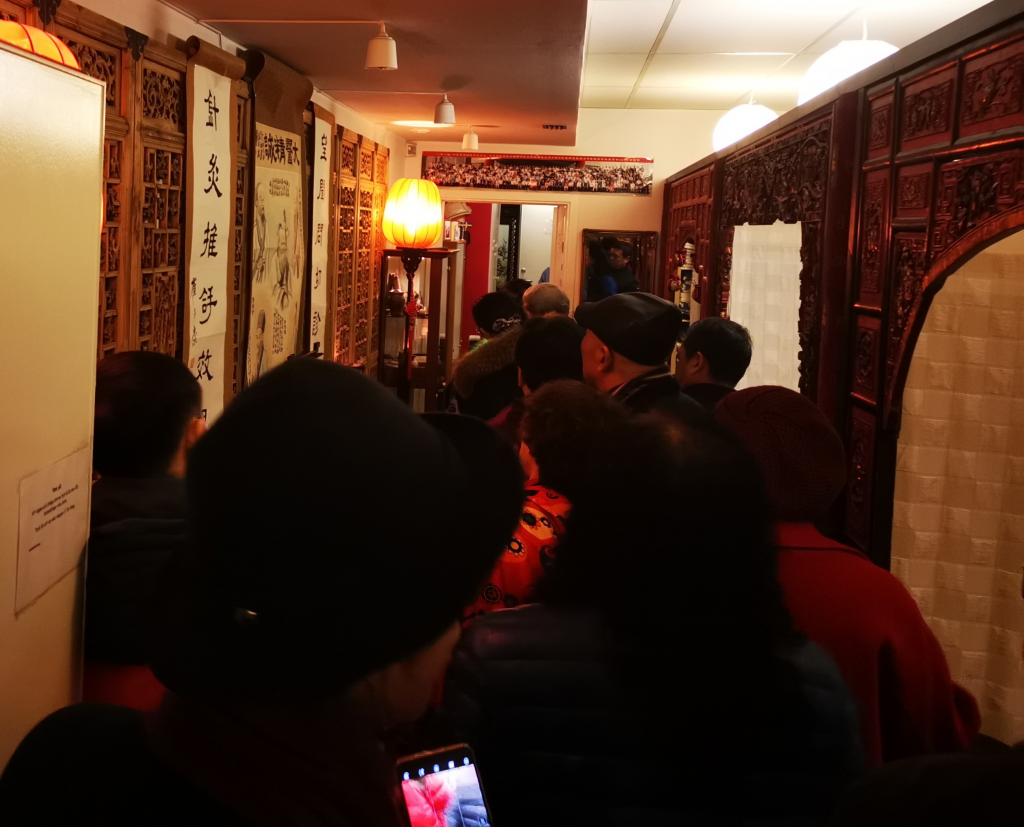
After thorough inspection by the leaders of the World Federation of China and the friendly consultation between the two sides, they jointly decided that the World Federation of Chinese Medicine Professional Level Recognition Department and the Swedish Society of Chinese Medicine will sign a cooperation framework agreement on the “Cooperation on the clinical superiority technology transfer of traditional Chinese medicine and the evaluation of professional titles of international Chinese medicine”.
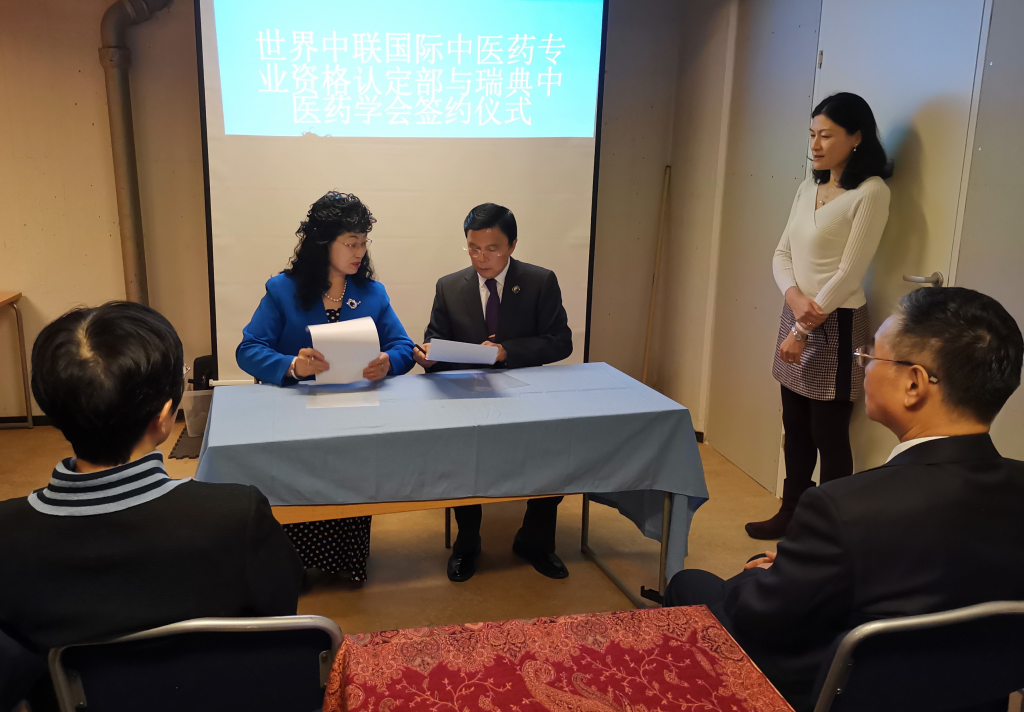
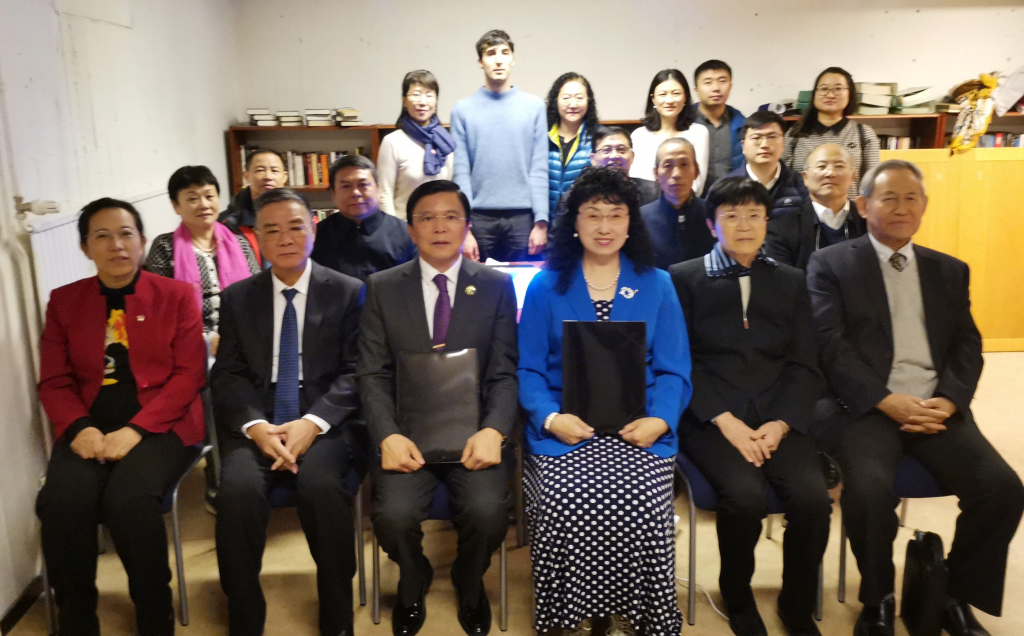
At 3 o’clock in the afternoon, under the witnesses of the WFCMS’ leaders and Guo Hao law Firm’s lawyer Jiemei, Professor Zheng Yuexian, the chief expert of the WFCMS and President of the Swedish Association of Chinese Medicine, Yang Chungui signed this important agreement.
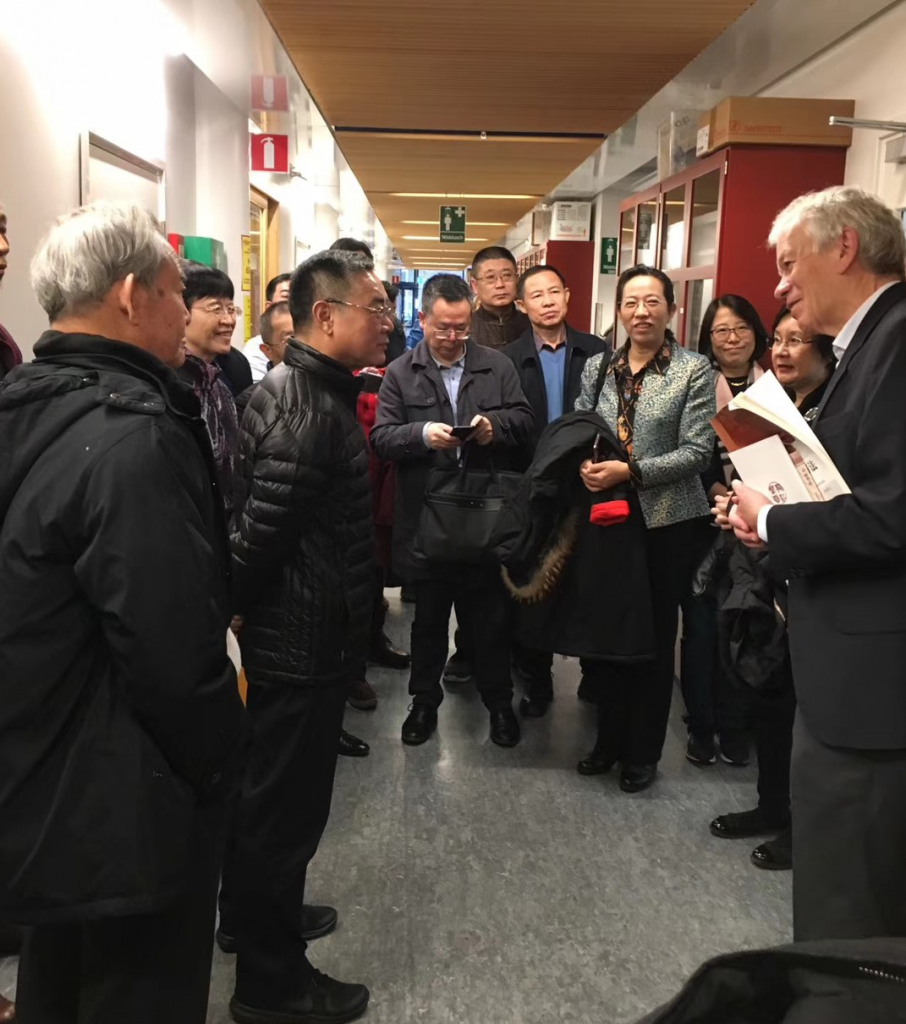
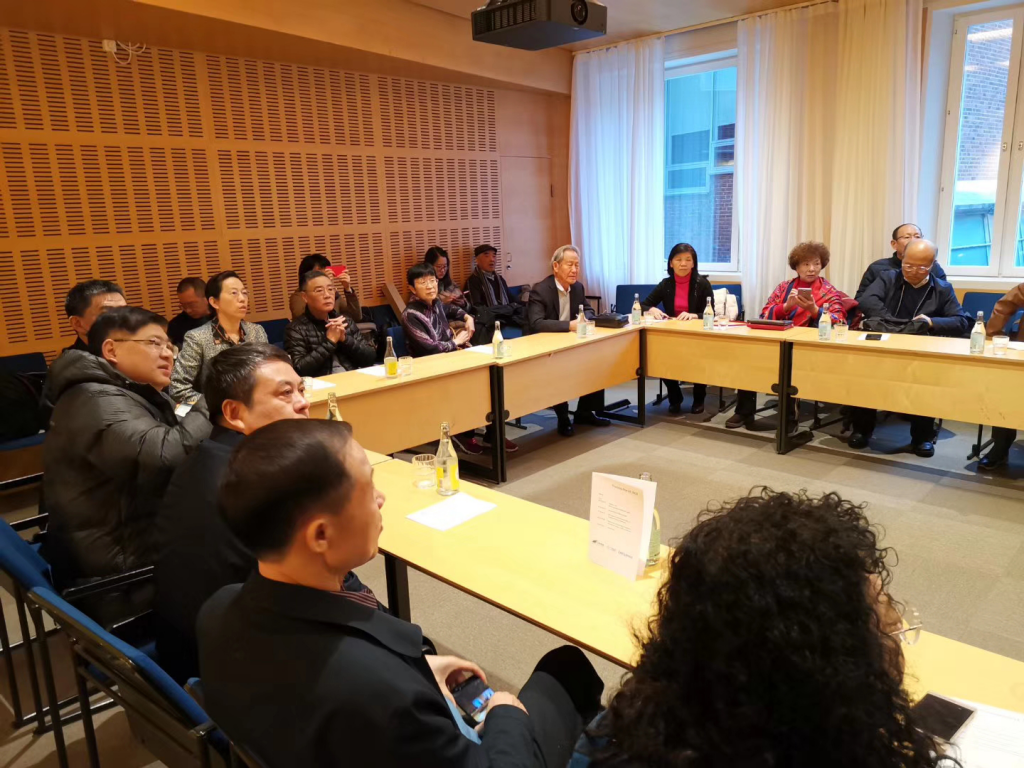
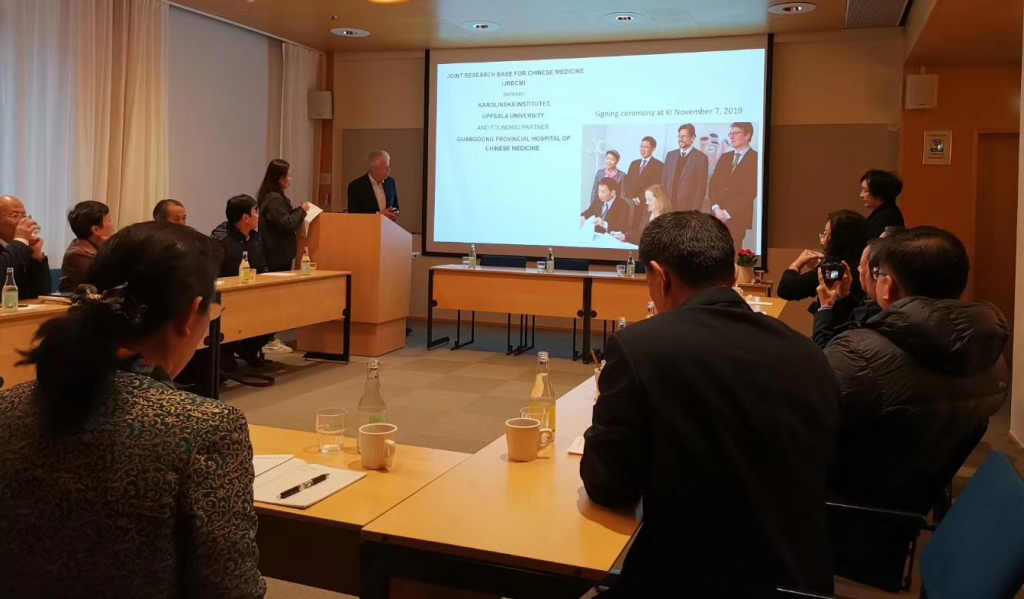
On the morning of the 14th, the World Federation of Chinese Medicine Societies experts visited Karolinska Institutet. The former Nobel Prize jury chair Professor Silas introduced the Karolinska Institute and Nobel Prize evaluation process to the delegation.
In the afternoon, the delegation concluded the intense academic study tour and flew back to China with Air China.
The World Federation of Chinese Medicine Societies is an international academic organization approved by the Chinese State Council and a member of the World Health Organization. It’s a Non-Governmental Organization (NGO).
(Translated and edited by Xuefei Chen Axelsson )

中国互联网协会理事长尚冰在2019(第五届)中国互联网法治大会上致辞。 钟欣 摄
北欧绿色邮报网报道:中国互联网协会主办的2019(第五届)中国互联网法治大会11月6日在北京召开。大会以“强化网络法治建设,护航数字经济繁荣”为主题,对互联网法治建设、数据保护、区块链等热点问题进行了探讨。
北京航空航天大学党委书记曹淑敏表示,《中共中央关于坚持和完善中国特色社会主义制度推进国家治理体系和治理能力现代化若干重大问题的决定》第一次将数据作为生产要素之一,与劳动、资本、土地等并列为生产资本,这些重大变化都是由于互联网以及信息技术的发展给国家法治、国家治理、国家经济发展以及相关立法工作带来的巨大机遇。
她认为,互联网法治涉及两大方面内容,一方面是互联网及其相关领域立法,另一方面是充分利用互联网等信息技术提高法治水平和治理能力。
中国互联网协会理事长尚冰对中国互联网法治建设提出四点建议:一是强化法治意识,夯实网络法治建设的基础;二是把握立法导向,为新技术、新业态留出发展空间;三是突出立法重点,做好网络强国建设基础性立法;四是强化法治建设,提升网络执法水平。
十二届全国人大常委会委员、副秘书长、法律委员会副主任委员李连宁表示,在互联网法治及其研究的过程中,一个重要的理念是要在坚持底线的前提下,尽可能为互联网经济的发展营造宽松的氛围,这在互联网法治研究和立法过程中需给予高度重视。
中央网信办政策法规局副局长李长喜表示,推动数据技术及应用发展,防范数据发展带来的风险,需要构建科学的数据治理体系,要在五个方面做出努力。包括建立与数据发展相适应的安全保障制度、进一步完善网络综合执法体系、进一步完善数据治理规则等。
最高人民检察院技术信息中心主任赵志刚表示,区块链技术在检察工作中可被用于司法办案、法律监督以及检察公共服务等多个场景,从而起到加强证据效力、规范诉讼程序、推动司法观念革新、促进检察监督实时化,助力提升检察公共服务的群众满意度。
工业和信息化部政策法规司司长梁志峰表示,数字经济已成为中国国民经济的重要组成部分,成为推动经济发展的新动能。让互联网在法治轨道上健康运行,一是要加强基础问题研究,为网络领域法治建设提供理论支撑;二是要完善互联网监管体系,优化数字经济发展环境;三是要加快推进电信法等进重点立法,完善互联网基础管理制度。(来源:中新网/ 记者 刘育英 )
2006年诺贝尔化学奖得主、世界顶尖科学家协会主席罗杰·科恩伯格当日在开幕式致辞。作者 张亨伟
北欧绿色邮报网援引中新社( 记者 李姝徵 )报道:第二届世界顶尖科学家论坛29日在中国(上海)自由贸易试验区临港新片区(以下简称临港新片区)开幕。
“我们想要看到更多科学上的交流和互动。”2006年诺贝尔化学奖得主、世界顶尖科学家协会主席罗杰·科恩伯格当日在开幕式致辞中表示,科学是无国界的,它是国际性的、非政治性的。
第二届世界顶尖科学家论坛29日在中国(上海)自由贸易试验区临港新片区开幕。作者 张亨伟
罗杰·科恩伯格指出,世界顶尖科学家论坛有两个目的:一是支持全球的年轻科学家;第二是支持基础科研的发展。他认为,当今科学发展呈现出“多点突破”和“交叉互融”的基本格局。开放、协同和共享的合作趋势,不但是人类应对共同挑战的基础,更是推动科学发展的前提。
据上海官方表示,举办世界顶尖科学家论坛,充分展示了上海以更加开放的态度,进一步融入全球科技创新体系,加强全方位国际合作的决心。
图为当日现场。作者 张亨伟
目前,上海正全力建设具有全球影响力的科技创新中心,搭建集聚全球顶尖科技人才、打造全球高层次合作的交流平台,是上海建设“创新之城”的核心内容之一。而随着临港新片区正式揭牌,这片曾经的滩涂地正向着成为中国对外开放的新高地迈进。
相较首届世界顶尖科学家论坛,本届论坛参与科学家人数较上一年更多。包括44位诺贝尔奖获得者、21位图灵奖、沃尔夫奖、拉斯克奖、菲尔兹奖得主在内的65位世界顶尖科学家,与100多位中国科学院院士、中国工程院院士和青年科学家齐聚临港新片区,共赴“智慧盛宴”。( 责任编辑查正富 主编陈雪霏)

“雪龙号”即将离开极地科考码头,开启第三十六次科学考察任务。 陈超 摄
北欧绿色邮报网报道:“雪龙”号极地科考船22日从其母港——位于上海浦东外高桥港区的中国极地科考码头启航,开始其第36次南极之行。
据悉,此前,“雪龙2”号中国科考船已于本月9日离开上海外高桥港前往深圳,拉开了中国第36次南极考察的序幕。22日,完成船舶大修后的“雪龙”号启航后,将在11月下旬与“雪龙2”号在南极中山站会师。

外高桥边检站民警登上“雪龙号” 办理出境检查手续。 陈超 摄
目前,南极中山站、内陆队、泰山站、恩克斯堡岛新站物资已经装船完毕,将搭乘“雪龙”号奔赴南极现场。据了解,本次考察将开展天文、高空、冰雪、海冰气象、地磁、环境、海洋等方面的科学考察工作。在恩克斯堡岛新站,将继续开展新站临建建设、工程地勘工作及部分科学考察工作。
第36次南极考察是一次承前启后、继往开来的重要考察活动。“雪龙2”号正式加入南极考察序列,与“雪龙”号形成南极考察编队,这是中国时隔35年再次以“双船作业”模式远征南极。此次“双船作业”,两艘极地考察破冰船首次组成编队赴南极考察,“双龙探极”工作模式将成为未来中国极地科考的一种新常态,将在考察范围、人员规模、考察深度和成果影响力等方面产生广泛而深刻的影响。

外高桥边检站开辟“绿色通道”,快速为该轮和科考人员办理了边防检查手续,助其顺利出境。 陈超 摄
当日,外高桥边检站开辟“绿色通道”,快速为该轮和科考人员办理了边防检查手续,助其顺利出境。外高桥边检站方面向记者介绍,本次考察队由446名队员组成。“雪龙”号极地科考船从上海母港出发后,将经停澳大利亚、新西兰、智利等国家前往南极考察,预计2020年4月中旬返回上海港。(来源:中新网/记者陈静 陈超 )
北欧绿色邮报网援引中新社(记者 孙自法)报道:“2019年度人类社会发展十大科学问题”16日在北京举行的首届世界科技与发展论坛上正式发布,这十大科学问题涵盖健康、环境、能源三大领域,其中就包括如何解决人类未来能源的问题。
2019年度人类社会发展十大科学问题包括健康领域4个问题和环境领域、能源领域各3个问题。4个健康问题分别是:如何预防并阻断新发传染病的大规模流行?社会变迁对人的身心健康有哪些影响?能否对未来人类疾病做出准确而全面的预测?哪些新技术可用于癌症的早期诊断和预后监测?
3个环境问题分别是:人类如何在安全的地球界限内继续发展?如何有效解决跨界空气、水和土壤的污染?如何实现对废水和污水的完全净化处理?
3个能源问题分别是:可控核聚变能否解决人类未来能源问题?怎样高效转化和存储新能源?大城市如何实现能源-水-食物供给的平衡和平等?
中国科学院院士、2019年度人类社会发展十大科学问题发布人蔡荣根指出,发展是人类社会的永恒追求,正是依赖于科学技术的创新发展,人类的生产生活获得了令人叹为观止的改善,同时也带来了令人忧虑的严峻挑战。
据了解,最新发布的这十大科学问题是围绕联合国2030年可持续发展议程提出的17项目标,聚焦人类可持续发展中最迫切、最基本、最具挑战性的需求,根据Scopus数据库相关科学研究热门关键词的检索结果,由中外知名科技期刊的编委、高端战略科学家反复讨论提出候选问题,并通过广泛的网络评选,经中国科协九届常委会学术交流专门委员会终审确定。(责任编辑查正富 主编陈雪霏)